When it comes to building a high-performance gaming PC, the motherboard plays a pivotal role in providing both stability and functionality. The ASUS ROG STRIX B850-F Gaming WiFi motherboard offers an impressive mix of features, designed specifically for gamers and PC enthusiasts looking to unlock the full potential of their AMD Ryzen processors. Whether you’re a competitive gamer or a content creator, this motherboard offers performance, connectivity, and customization options that make it stand out in its class. It’s features a sleek and modern aesthetic with an aggressive, yet stylish, look. The matte black PCB is accented with brushed metal finishes and customizable RGB lighting, giving it a premium feel. The integrated heatsinks are well-designed to ensure efficient cooling, even during long gaming sessions or demanding tasks. The overall build quality feels sturdy and solid, adding to the sense of reliability that ASUS ROG products are known for.
- AMD AM5 Chipset
- AMD ZEN 5 CPU Architecture
- AVX-512 Implementation
- Specification
- Peripheral functionality: USB ports, network interfaces, I/O
- PCIe Slot Q-Release
- REALTEK ALC4080 CODEC
- Power Phase Design & Component
- How We Test ASUS ROG STRIX B850-F Gaming WIFI?
- System Information
- ASUS ROG STRIX B850-F GAMING WIFI
- Pros
- Cons
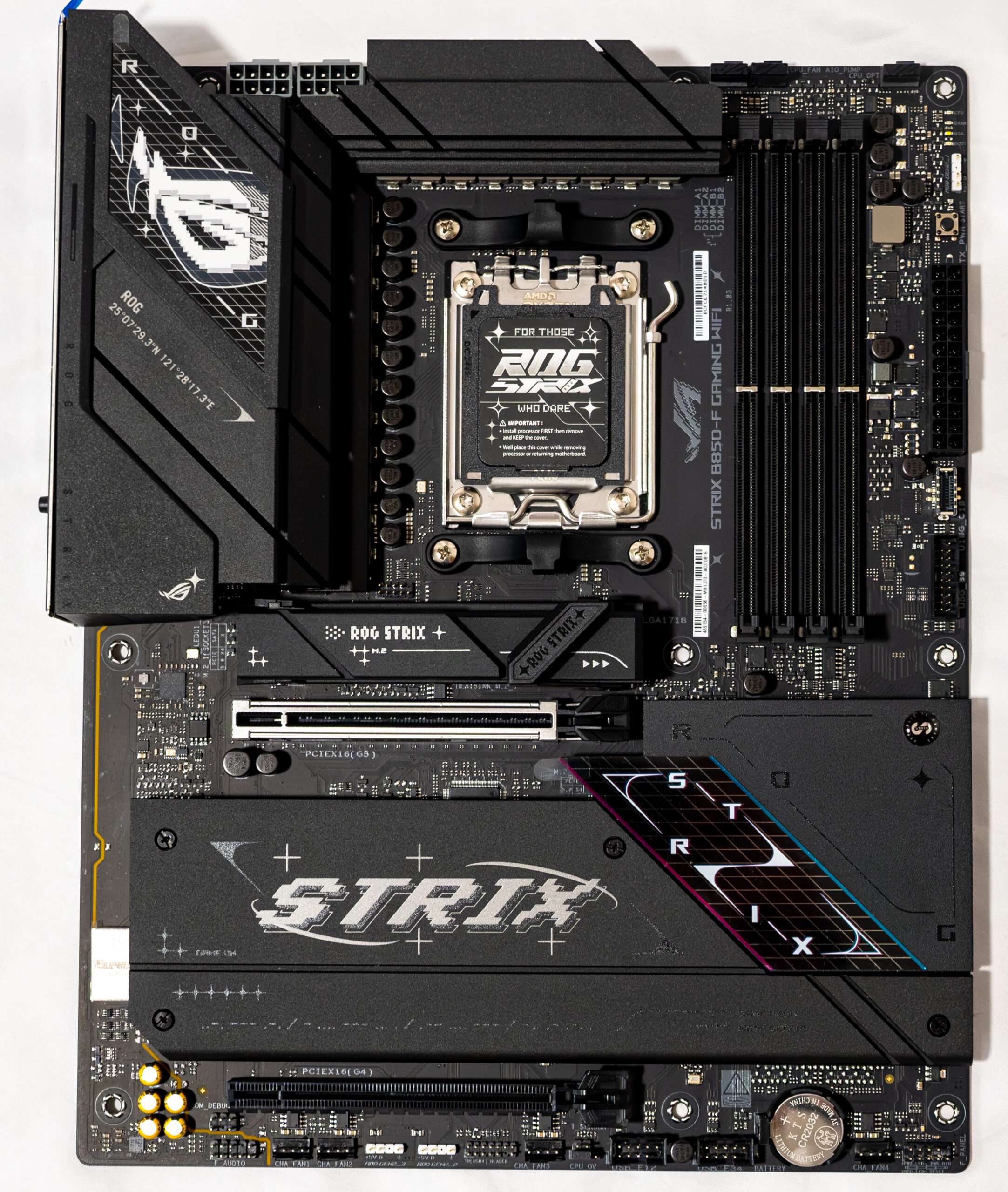
On the back features several controllers along with some standard circuitry. The PCB is meticulously crafted, with all soldering points smoothed and polished to eliminate sharp edges. There are no protective backplate on the VRM area.
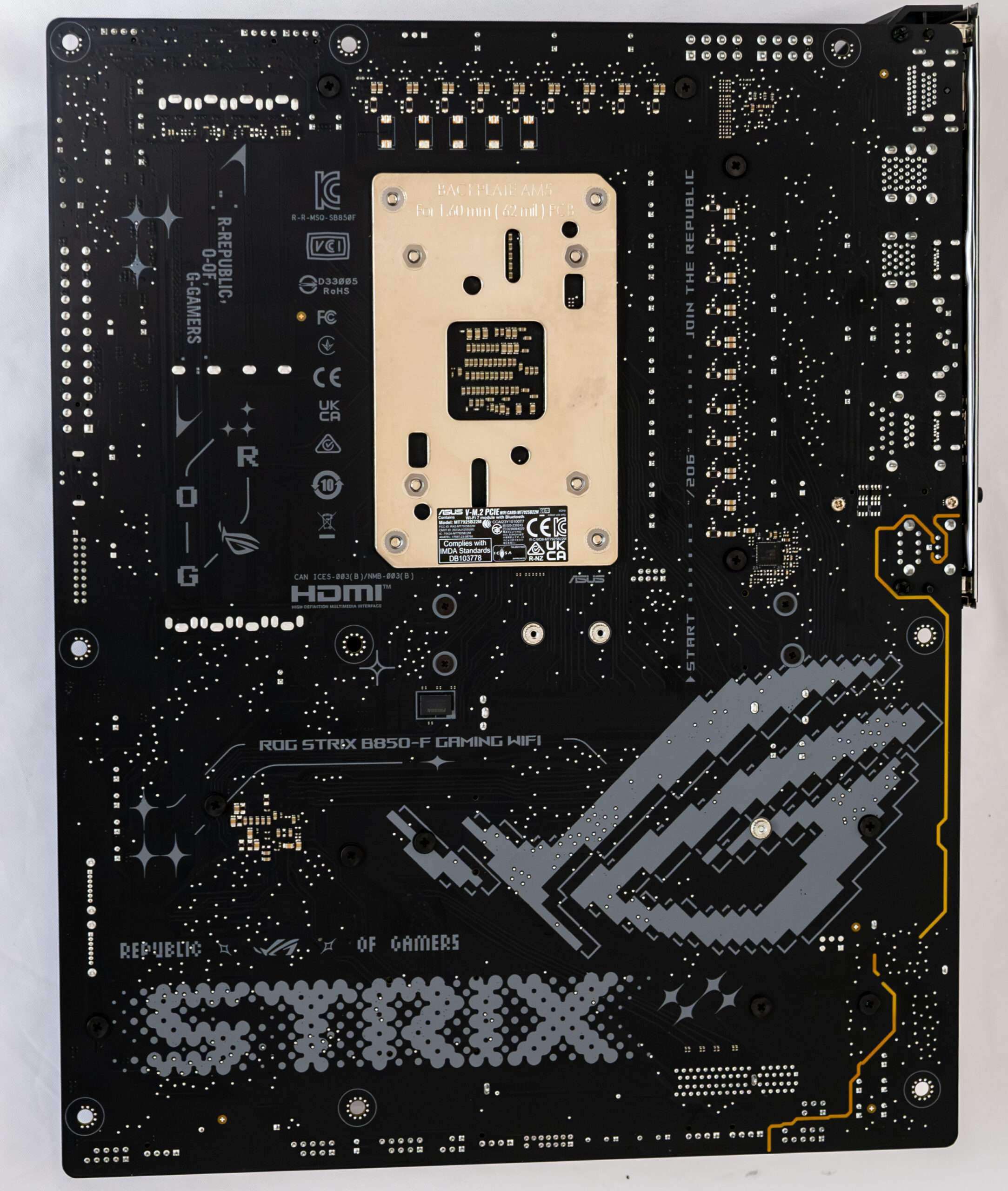
AMD AM5 Chipset
As you know, with the release of the 9xxx generation of AMD processors, the chipsets from AMD was also updated, the new generation received the number 8, that is, X870/B850 and so on. Today we will get acquainted for the first time with the mid-range chipset – AMD B850.
Table of the main differences between AM5 chipsets from two years ago and the latest generation.
| Chipsets | B650/ B650E | B850 | X870 | X670/ X670E | X870E |
|---|---|---|---|---|---|
| Compatibility with AMD processors | Ryzen 7xxx/8xxx/9xxx | ||||
| PCIe Version (CPU) | 4.0 & 5.0/ 5.0 | 4.0 & 5.0 | 5.0 | 4.0 & 5.0/ 5.0 | 5.0 |
| Number of PCIe lanes (processor) | 28 | ||||
| Number of PCIe lanes from the processor to the chipset | x4 PCIe 4.0 | ||||
| PCIe version (chipset) | 3.0 & 4.0 | ||||
| Number of PCIe lanes (chipset) | 12 (8 x 4.0 & 4 x 3.0) | 12 (8 x 4.0 & 4 x 3.0) | 12 (8 x 4.0 & 4 x 3.0) * | 20 (12 x 4.0 & 8 x 3.0) | 20 (12 x 4.0 & 8 x 3.0) * |
| RAM generation | DDR5 | ||||
| Number of RAM channels | 2 | ||||
| Maximum number of RAM slots | 4 | ||||
| Maximum RAM | 256 GB | ||||
| Number of SATA 6.0 Gb/s ports up to | 4 | 4 | 4 | 8 | 8 |
| USB4 ports (40Gbps) up to | optional, at the manufacturer’s discretion via a third-party controller | optional, at the manufacturer’s discretion via a third-party controller | 2 (required) via a third-party controller with 4 PCIe lanes allocated to it | optional, at the manufacturer’s discretion via a third-party controller | 2 (required) via a third-party controller with 4 PCIe lanes allocated to it |
| USB 3.2 Gen 2×2 ports (20Gbps) up to | 1 | 1 | 1 | 2 | 2 |
| USB 3.2 Gen 2×1 (10Gbps) / Gen 1×1 (5Gbps) ports up to | 6 | 6 | 6 | 8 | 8 |
| USB 2.0 ports up to | 6 | 6 | 6 | 12 | 12 |
| PCIe x16 slot configuration (from processor) | only x16/ x16 or x8+x8 or x8+x4+x4 | x16 or x8+x8 or x8+x4+x4 | x16 or x8+x8 or x8+x4+x4 | only x16/ x16 or x8+x8 or x8+x4+x4 | x16 or x8+x8 or x8+x4+x4 |
| Possibility of overclocking by bus frequency | Yes | ||||
The AMD B850 chipset will be based on the same Promontory 21 chip as the various variants of the B650, X670 and X870 chipsets. In this case, however, it no longer requires mandatory USB4 support. So what is the difference compared to B650? The boards using the old chipset usually only support PCIe 4.0 ×16 for a graphics card and sometimes PCIe 5.0 ×4 for SSDs – but often the M.2 slots only support PCIe 4.0 ×4. The new B850 platform changes this, with B850 boards requiring one of the M.2 slots for SSDs should to support PCIe 5.0 ×4.
Some boards may also support PCIe 5.0 ×16 for a graphics card, but this is optional (not mandatory). The important thing is that it is not prohibited, though, so there may be some boards that provide this (but not USB4, which would separate them from X870). By the way, leaked documents from May talked about the Gen5 support situation being the other way around, with PCIe 5.0 for graphics cards and PCIe 4.0 for SSDs. The current version of the specs is likely a better idea since SSDs benefit from PCIe 5.0 much more.
SATA, USB and PCIe 4.0 lane port support from the chipset itself is probably unchanged from B650. This chipset still supports USB 20 Gbps (USB 3.2 Gen 2×2). B850 boards, by the way, will support ×8/×8 lane split for graphics cards just like X870 and X870E.
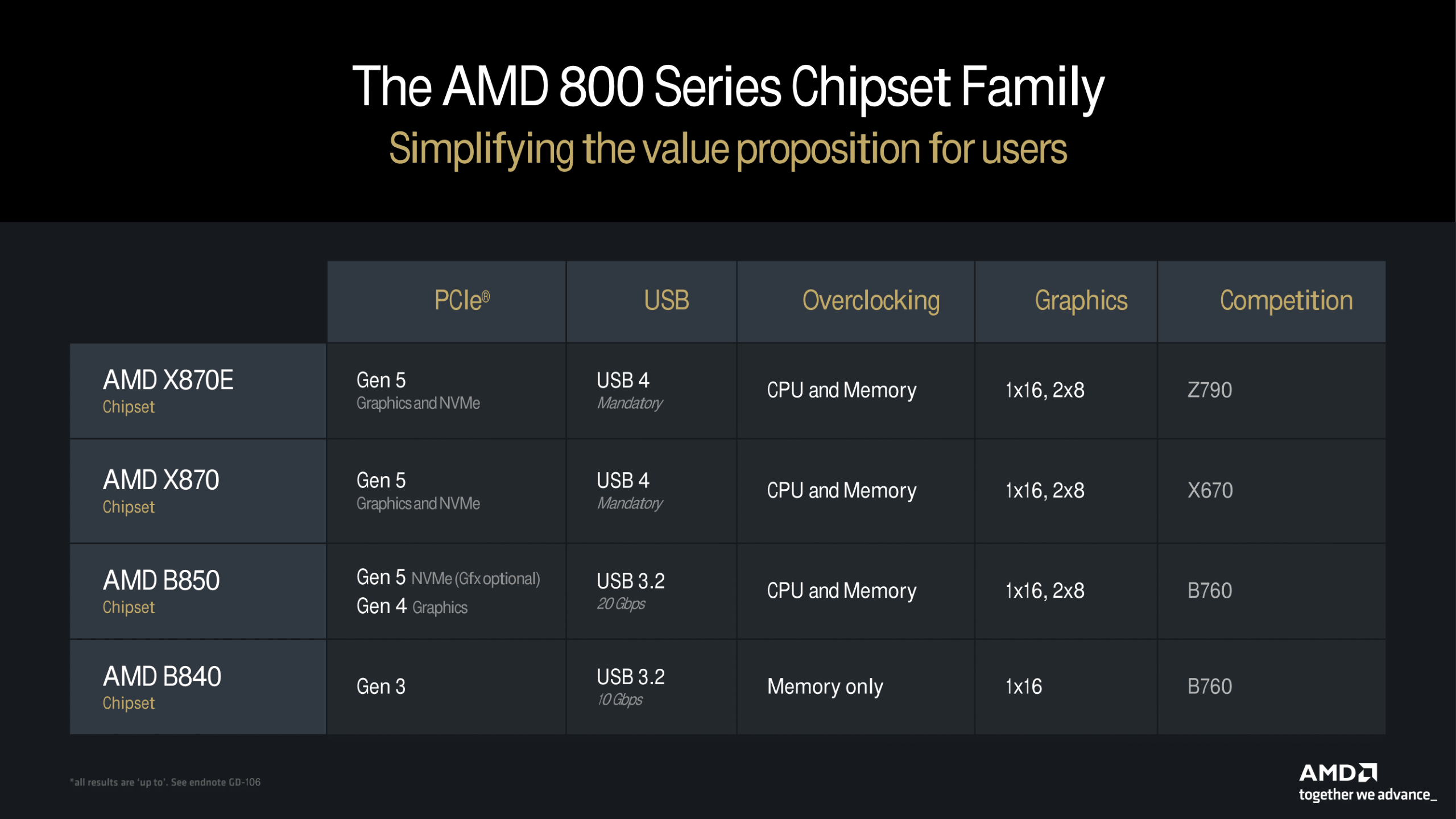
AMD’s X870E and X870 chipsets will both support PCIe Gen5 for both graphics and NVMe as a mandatory requirement for motherboard vendors. Additionally, both chipsets will include USB4 support, allow CPU and memory overclocking, and provide either a single PCIe Gen5 x16 graphics slot or a dual x8-lane configuration.
The X870E chipset retains the dual-chipset design of X670E, utilizing two Promontory 21 dies. This setup helps optimize trace routing by positioning one chipset die closer to the PCIe slots while also increasing the number of general-purpose PCIe lanes. In contrast, all other chipsets use a single-chip design.
The B850 chipset lowers the requirement for PCIe graphics to Gen4 by default but retains the option to support Gen5. It also mandates USB 3.2 at 20Gbps. Meanwhile, the B840 chipset is essentially an entry-level A-series chipset, akin to the previous A320, but rebranded—potentially to create market confusion. This lower-end chipset is limited to PCIe Gen3, supports USB 3.2 at 10Gbps, does not allow CPU overclocking, and features only a single x16 graphics slot.
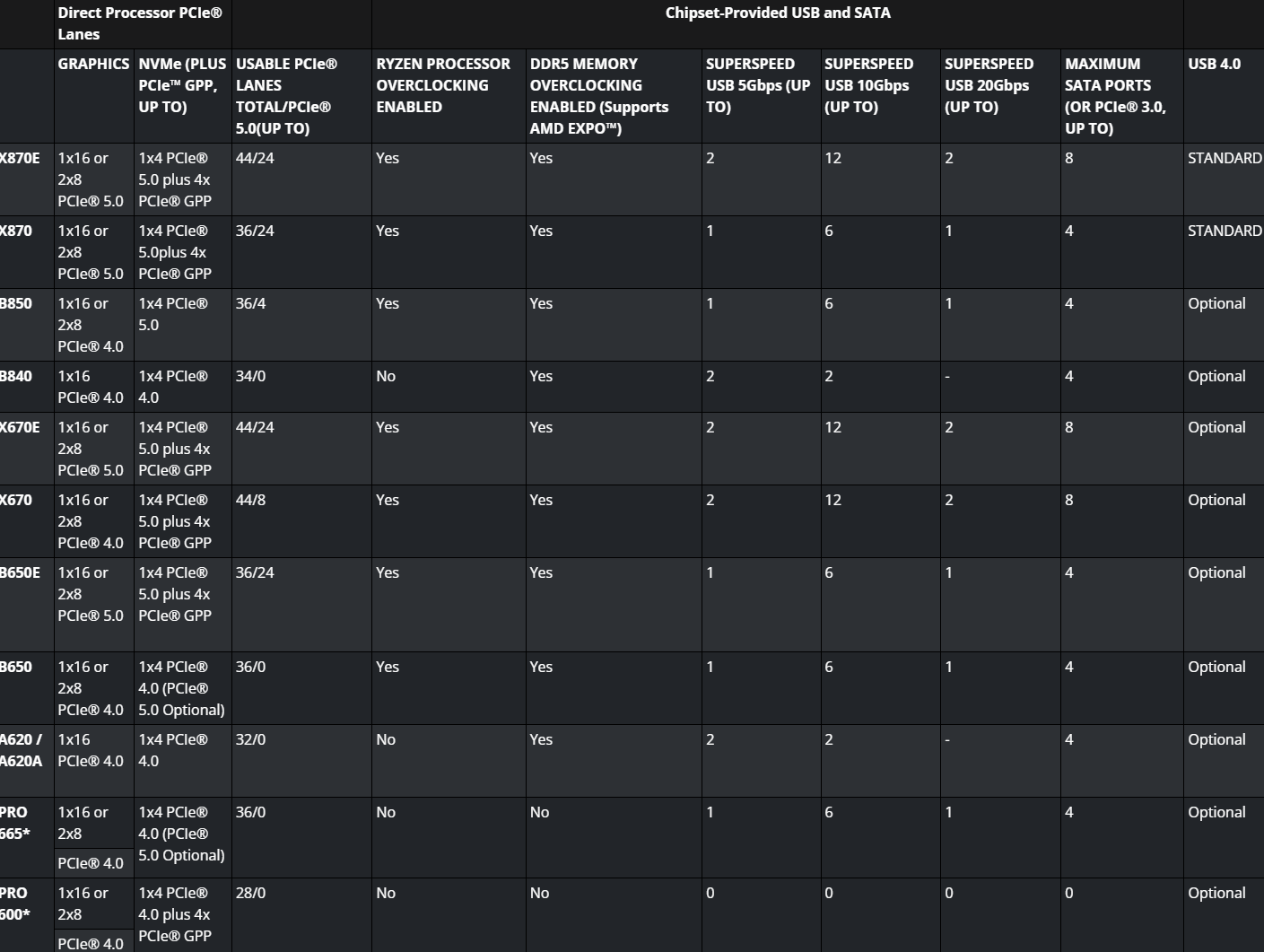
AMD ZEN 5 CPU Architecture
The Ryzen 9 9950X is set to become AMD’s new flagship processor, featuring 16 cores and 32 threads with boost speeds reaching up to 5.7 GHz. Notably, it will operate with a 170W TDP and come equipped with 80MB of total cache, making it a powerful addition to AMD’s lineup.
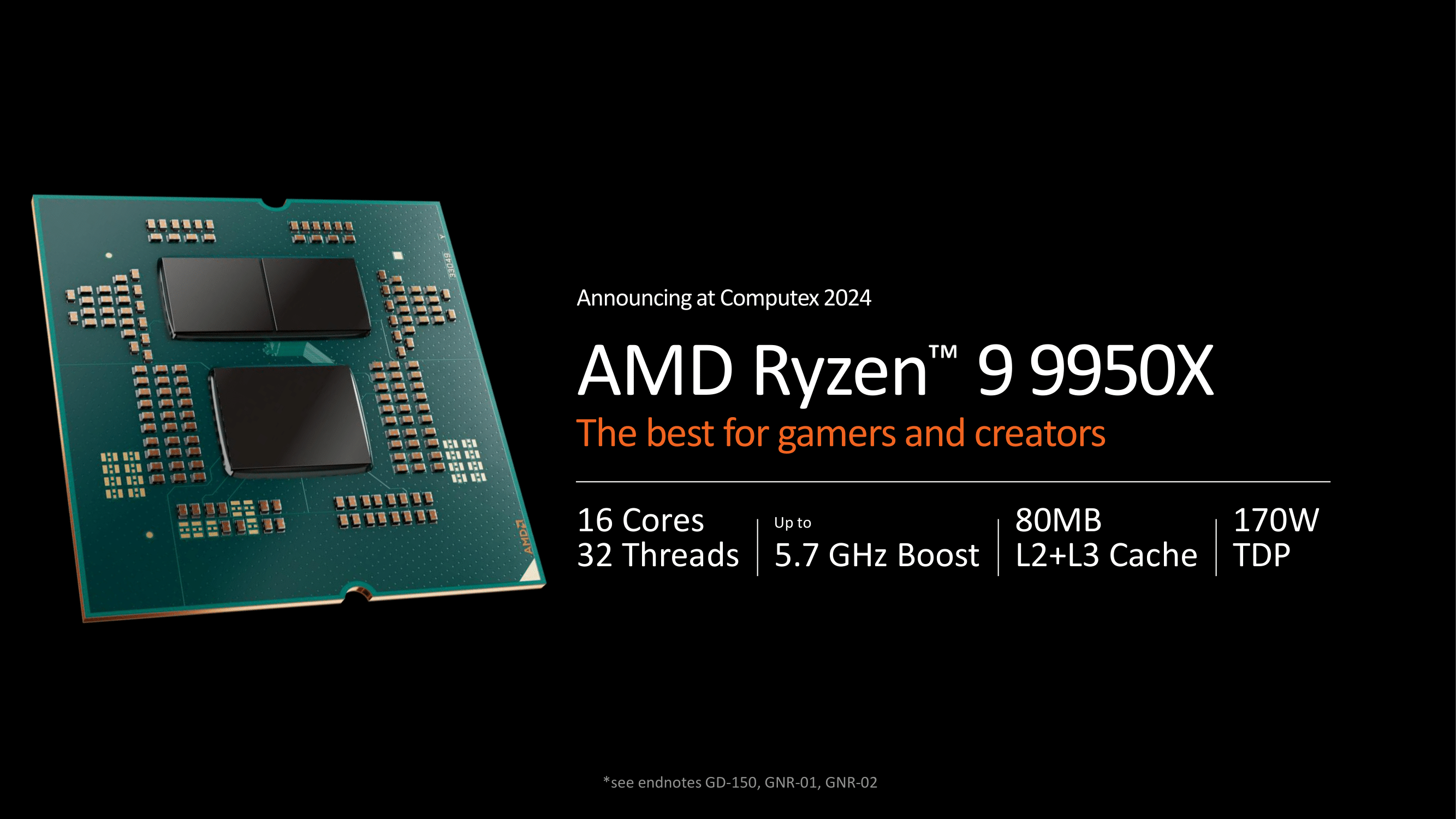
The Ryzen 9 9900X, another high-end SKU, will feature 12 cores and 24 threads, with a boost clock of up to 5.6 GHz. Compared to its predecessor, it has a lower TDP of 120W, improving power efficiency while still delivering strong performance. It also comes with 76MB of cache.
In the mid-range segment, the Ryzen 7 9700X will feature 8 cores and 16 threads, reaching a boost speed of up to 5.5 GHz while maintaining a lower TDP of 65W. It comes with 40MB of cache, offering a 100 MHz boost increase over its predecessor while significantly reducing power consumption from 105W in previous models.
For entry-level users, the Ryzen 5 9600X will include 6 cores with a boost clock of up to 5.4 GHz. Like the 9700X, it will also have a 65W TDP, delivering strong performance for mainstream users and gamers seeking an optimal balance between power efficiency and thermal management.

The new processors are designed to deliver an average 16% increase in Instructions Per Cycle (IPC) performance over the previous Zen 4 architecture. This improvement means that, at the same clock speeds and core counts, Zen 5 chips are 16% more efficient, though actual gains will vary depending on the workload. Unlike the more incremental updates seen in past Zen iterations, AMD positions Zen 5 as a significant generational leap over Zen 4, highlighting substantial architectural advancements.
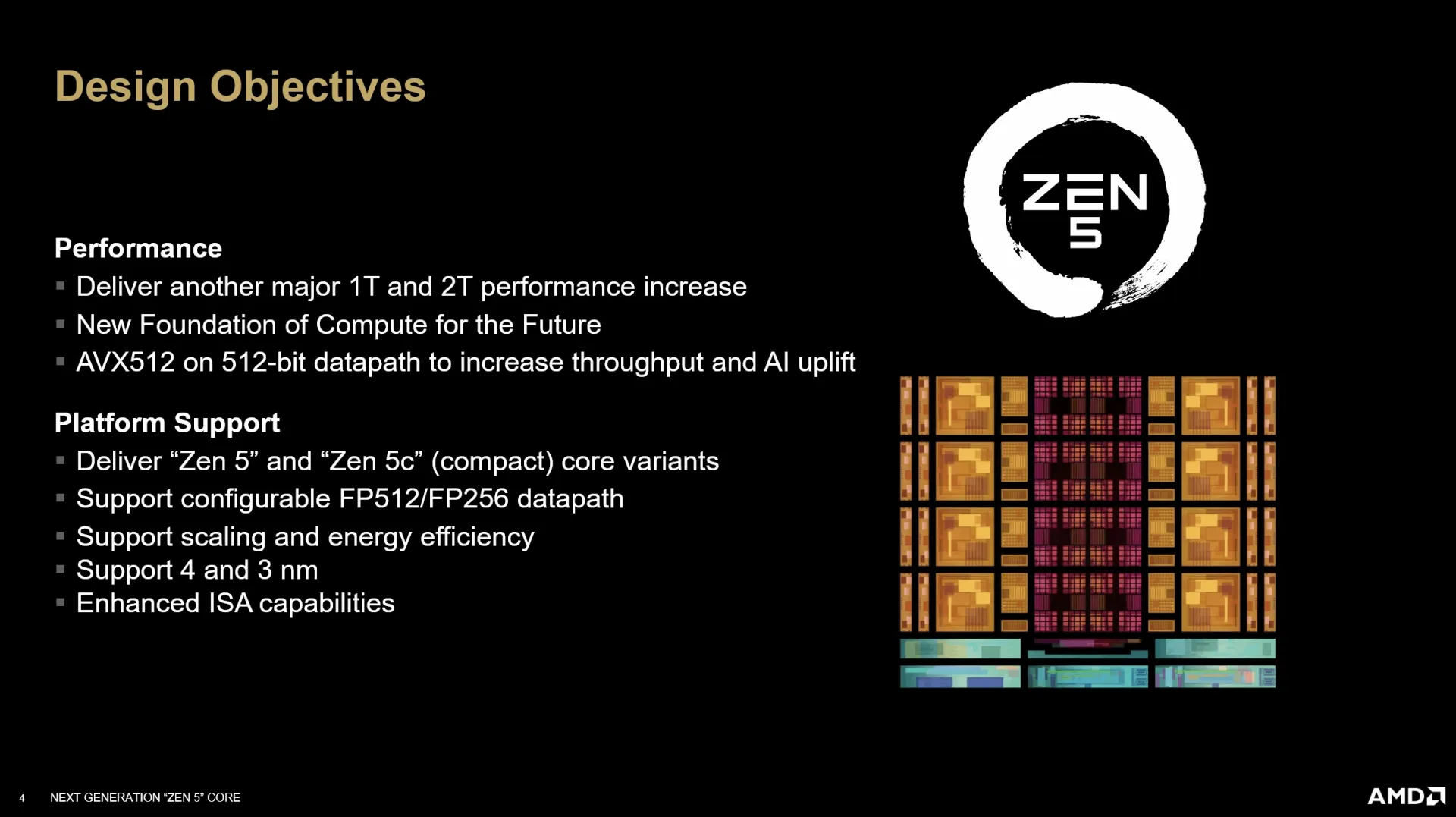
AMD’s desktop Zen 5 processors, codenamed Granite Ridge, represent the latest in the company’s high-performance consumer lineup. In this article, we’ll focus on the Ryzen 9 9950X. Since Zen 5’s architecture was already introduced with Strix Point, our focus here will be on the key differences between AMD’s mobile and desktop Zen 5 cores. With a higher power budget and no die space allocated to an NPU, the desktop Zen 5 variant benefits from increased cache, an enhanced floating-point unit (FPU), and higher clock speeds.
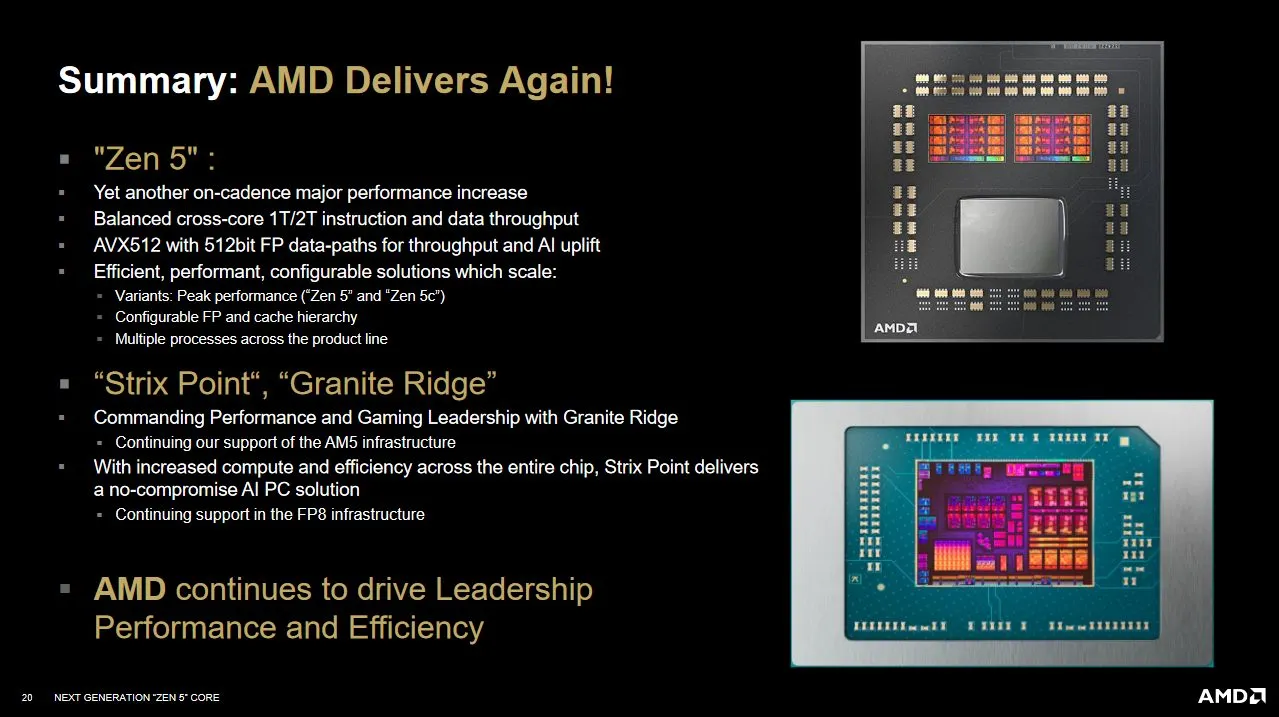
The Ryzen 9 9950X continues AMD’s chiplet-based design, a hallmark of its desktop processors since Zen 2. It features two Core Complex Dies (CCDs) connected to an IO die, which houses the memory and PCIe controllers along with other essential IO functions.
While AMD has refined its architecture with each generation, the 9950X builds on those advancements. Each CCD contains eight Zen 5 cores and 32MB of shared L3 cache, maintaining the baseline established with Zen 3. The IO die, carried over from Zen 4, provides DDR5 support and includes a small integrated GPU. All these components are linked together by AMD’s Infinity Fabric interconnect.
AVX-512 Implementation
AMD has traditionally taken a conservative approach to ISA extensions, with vector extensions being a key example. Athlon processors executed 128-bit SSE instructions as two 64-bit micro-ops until the launch of Phenom in 2007. Native 128-bit execution remained standard until Zen 2 arrived in 2019.Zen 4 marked a shift from this trend by executing 512-bit operations in a single micro-op, though with one notable exception
Zen 5 pushes this evolution even further, adopting a split approach to AVX-512. The desktop variant leverages its larger power and area budget for a more aggressive AVX-512 implementation, while the mobile version takes a more conservative route. Compared to its mobile counterpart, desktop Zen 5 features several key differences:
- Fully 512-bit vector register file entries
- FP units with full 512-bit vector width
- Lower FP add latency, reduced from 3 cycles in Zen 4 and mobile Zen 5 to 2 cycles
- Improved data cache throughput, supporting 2×512-bit loads per cycle (compared to just one on Zen 4 and mobile Zen 5)
- Potentially expanded mask register file entries
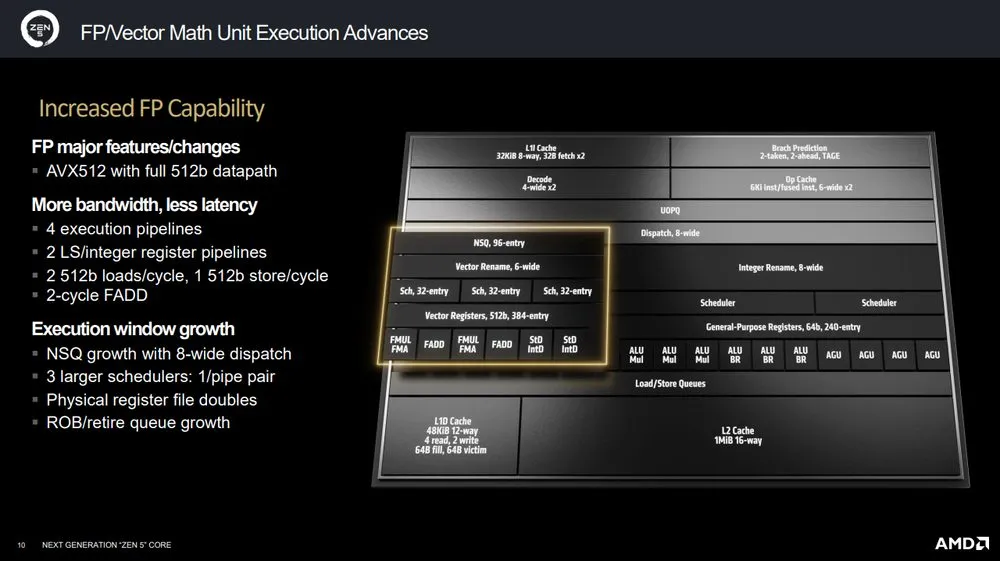
Specification
| Supported Processors | AMD Ryzen 7xxx/8xxx/9xxx under AM5 |
|---|---|
| Processor socket | AM5 |
| Chipset | AMD B850 |
| Memory | 4×DDR5, up to 256GB, up to DDR5-8000 (XMP/Expo), dual channels |
| Audio subsystem | 1×Realtek ALC1220P (7.1) with Nahimic caps |
| Network controllers | 1 × Intel Ethernet 2.5 Gbps 1 × MediaTek Dual Band Wireless MT7925 (Wi-Fi 6E 802.11a/b/g/n/ac/ax/be (2.4/5/6 GHz) + Bluetooth 5.4) |
| Expansion slots | 1×PCI Express 5.0 x16 (x16) [CPU] 1×PCI Express 4.0 x4 (x4 mode) [Chipset] 1x M.2 Socket for MediaTek Wireless |
| Storage connectors | 2×SATA 6Gb/s (B850) [Chipset] 1×M.2_1 (CPU, PCIe 5.0 x4 for 2280/2 5 80/22110/2 5 110 devices) 1×M.2_2 (CPU, PCIe 5.0 x4 for 2280/2 5 80/22110/2 5 110 devices) 1×M.2_3 (Chipset, PCIe 4.0 x4 for 2280/2 5 80/22110/2 5 110 devices) ** 1×M.2_4 (Chipset, PCIe 4.0 x4 for 2280/2 5 80/22110/2 5 110 devices) ** M.2_3 slot shares bandwidth with PCIEX16(G4). When PCIEX16(G4) slot is operating, M.2_3 will be disabled. |
| USB ports | Rear USB (Total 12 ports) 1 x USB 20Gbps port (1 x USB Type-C®) 3 x USB 10Gbps ports (2 x Type-A + 1 x USB Type-C®) 4 x USB 5Gbps ports (4 x Type-A) 4 x USB 2.0 ports (4 x Type-A) Front USB (Total 6 ports) 1 x USB 10Gbps connector (supports USB Type-C®) 1 x USB 5Gbps header supports 2 additional USB 5Gbps ports 2 x USB 2.0 headers support 4 additional USB 2.0 ports * USB Type-C® power delivery output: max. 5V/3A |
| Rear panel connectors | 1 x USB 20Gbps port (1 x USB Type-C®) 3 x USB 10Gbps ports (2 x Type-A + 1 x USB Type-C®) 4 x USB 5Gbps ports (4 x Type-A) 4 x USB 2.0 ports (4 x Type-A) 1 x DisplayPort 1 x HDMI™ port 1 x Wi-Fi module 1 x Intel® 2.5Gb Ethernet port 2 x Audio jacks 1 x Optical S/PDIF out port 1 x BIOS FlashBack™ button 1 x Clear CMOS button |
| Other internal elements | 24-pin ATX power connector 2x 8-pin EPS12V power connector |
| Form factor | ATX (305×226 mm) |
| Price | SGD $539 |
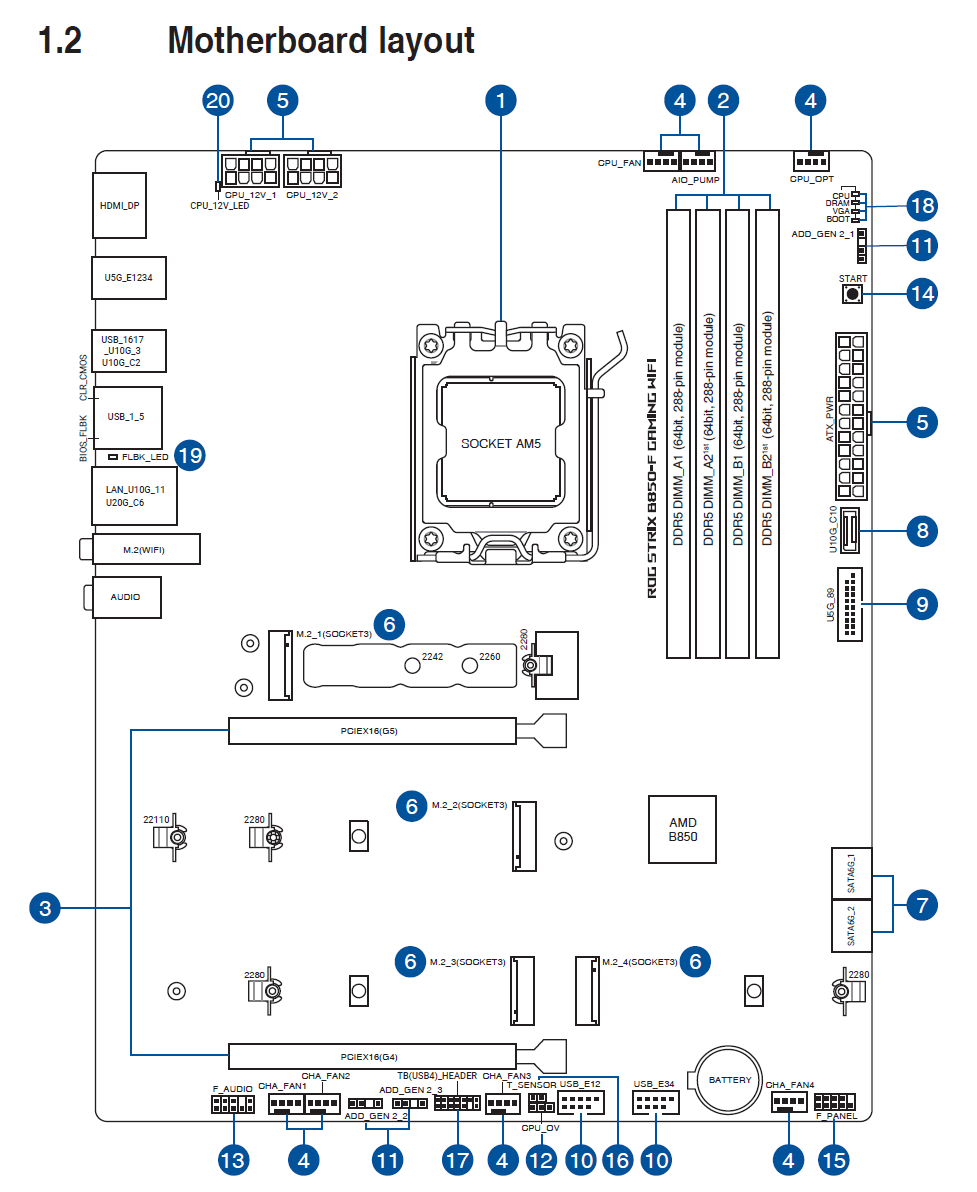
Peripheral functionality: USB ports, network interfaces, I/O
Now it’s the turn of USB ports and other I/O. And let’s start with the back panel, where most of them are displayed.
On the back I/O panel of connections including 1x DisplayPort 1.4 (iGPU), 1x HDMI 2.1 (iGPU), 2 x USB-A 3.2 Gen 2 (10Gb/s),1 x USB-C 3.2 Gen 2 (10Gb/s), 1 x USB-C 3.2 Gen 2×2 (20Gb/s), 4x USB 3.1 Gen1 (5Gb/s), 4 x USB-A 2.0 (480Mb/s), 1x 2.5GBase-T (Intel), Mediatek WIFI 7. Also present on the rear panel feature for the bios flashback is included.

The board has four DIMM slots for installing memory modules. The board supports ECC and unbuffered DDR5 (non-ECC) memory, and the maximum memory capacity is 256 GB. Of course, EXPO and XMP profiles are supported.
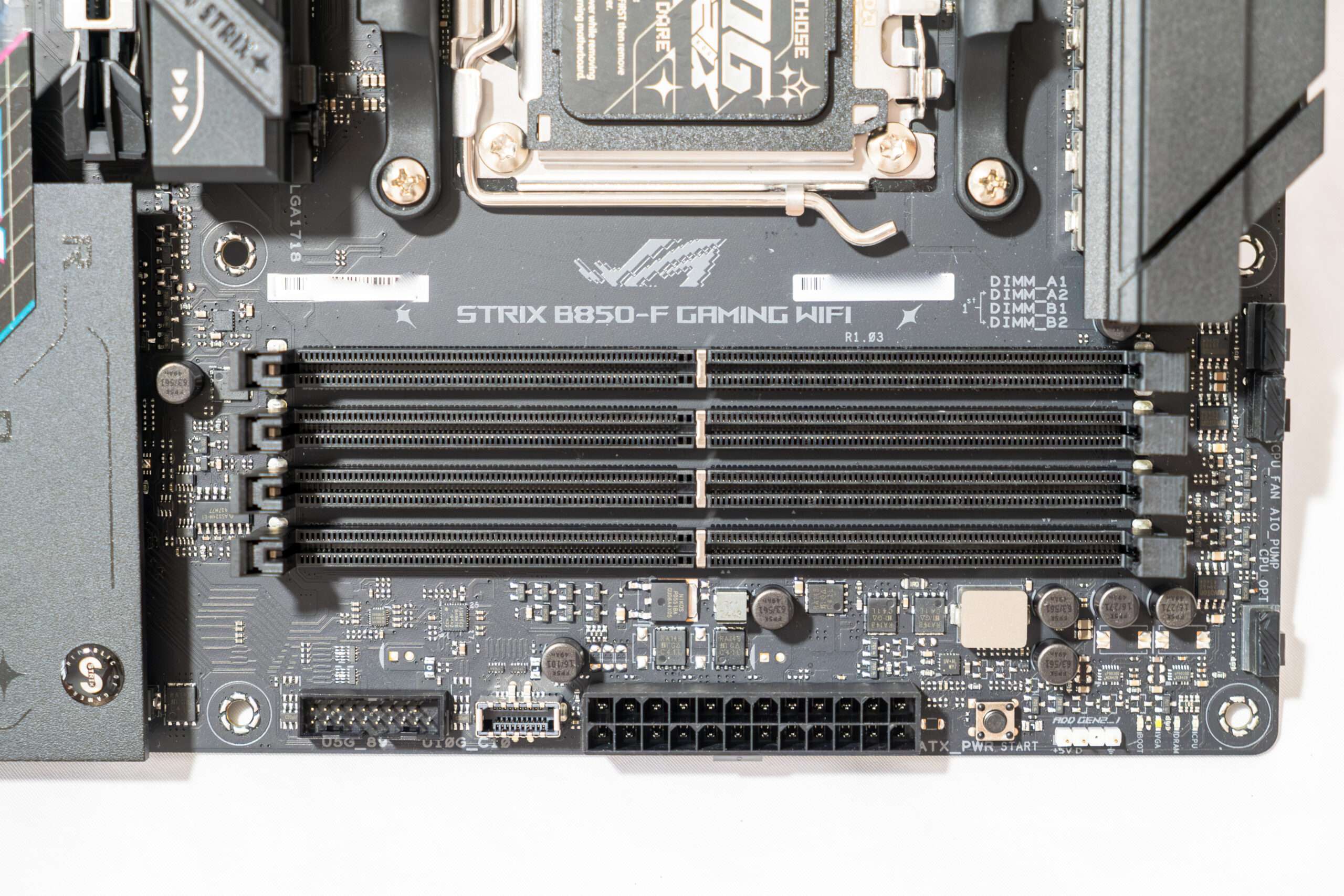
On the side of the motherboard, there are two Serial ATA 6 Gb/s ports, which are integrated through the B850 chipset and support RAID configurations. Additionally, the board includes one USB 3.0 header and one USB – Type C header for front panel connectivity.
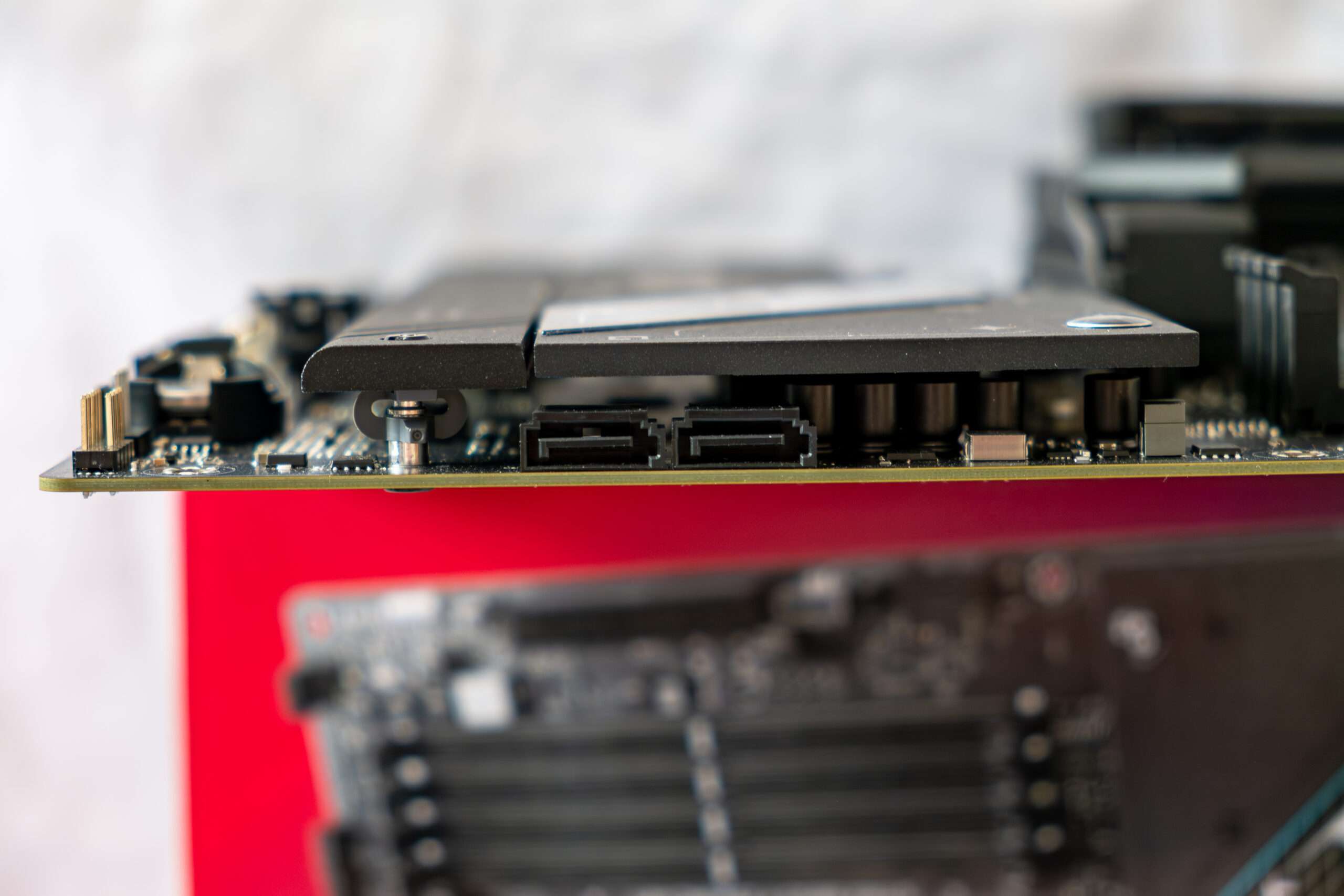
The PCIe x16 slot has stainless steel and zinc alloy reinforcement that increases durability (which can be important if you change graphics cards quite often, but more importantly, such a slot can more easily withstand bending loads in case of installing a very heavy top-level graphic card. In addition, such protection protects the slot from electromagnetic interference.
The ROG team has completely redesigned the M.2 Q-Release. The M.2 slot supports blazing-fast read and write speeds of up to 16 GB/s, while the remaining slot still delivers an impressive 8 GB/s transfer rate. To manage the heat from next-gen storage, M.2 slots are equipped with substantial heatsinks for effective thermal dissipation.
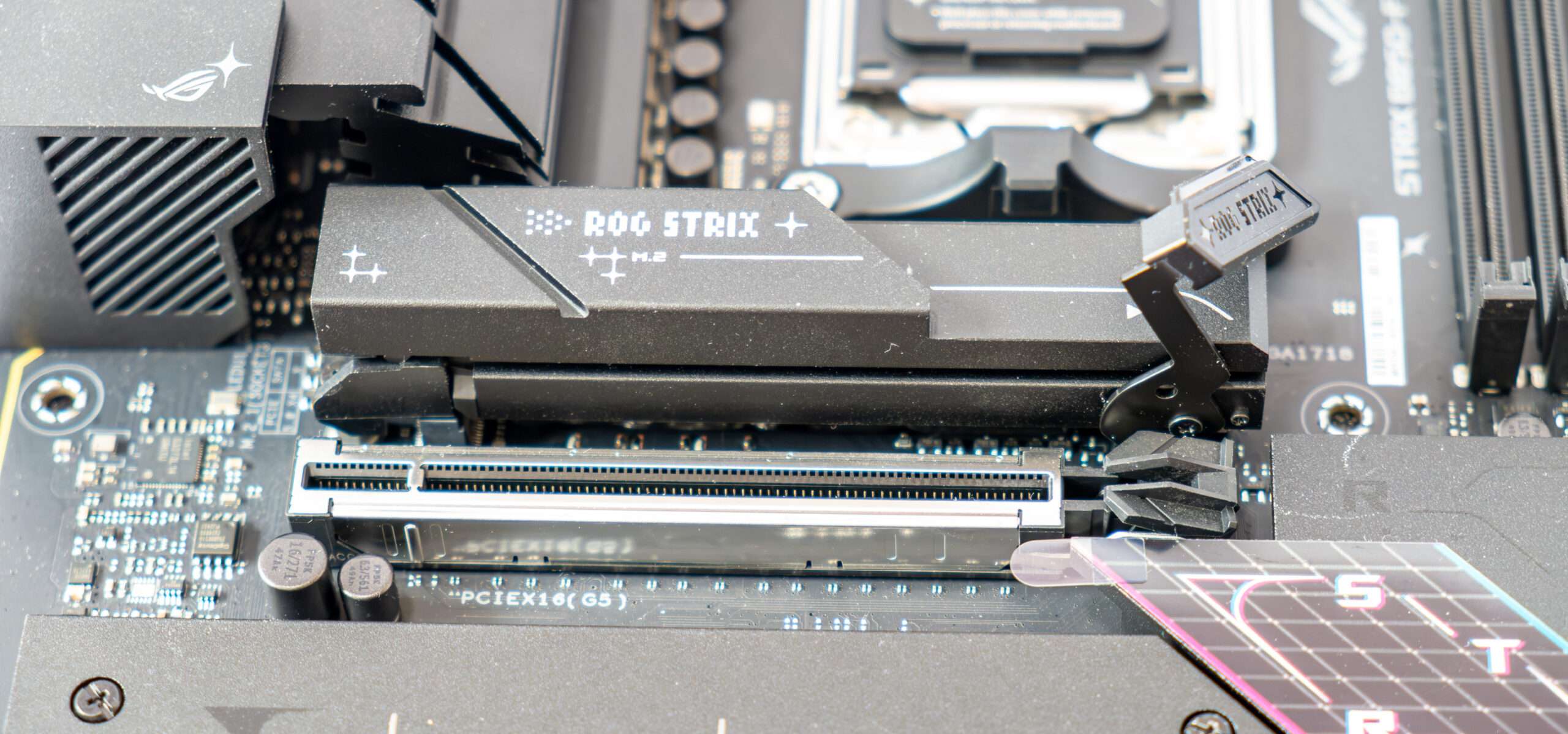
PCIe Slot Q-Release
The PCIe x16 slot features a convenient Q-Release Slim mechanism for easy removal of video cards. Simply lift the video card near the mounting bracket area, and the lock will disengage automatically.
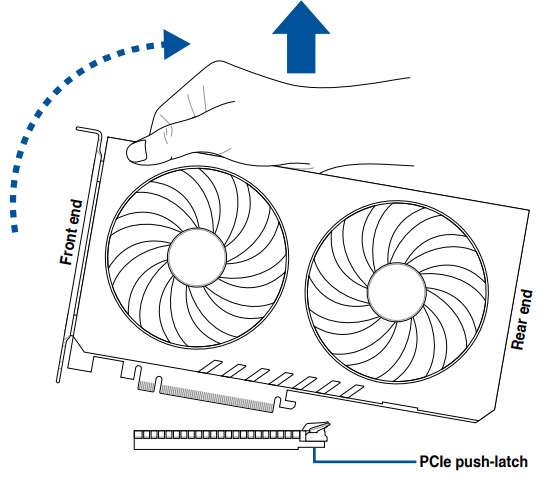
There are two 8-pin EPS12V connectors supplying power to the processor
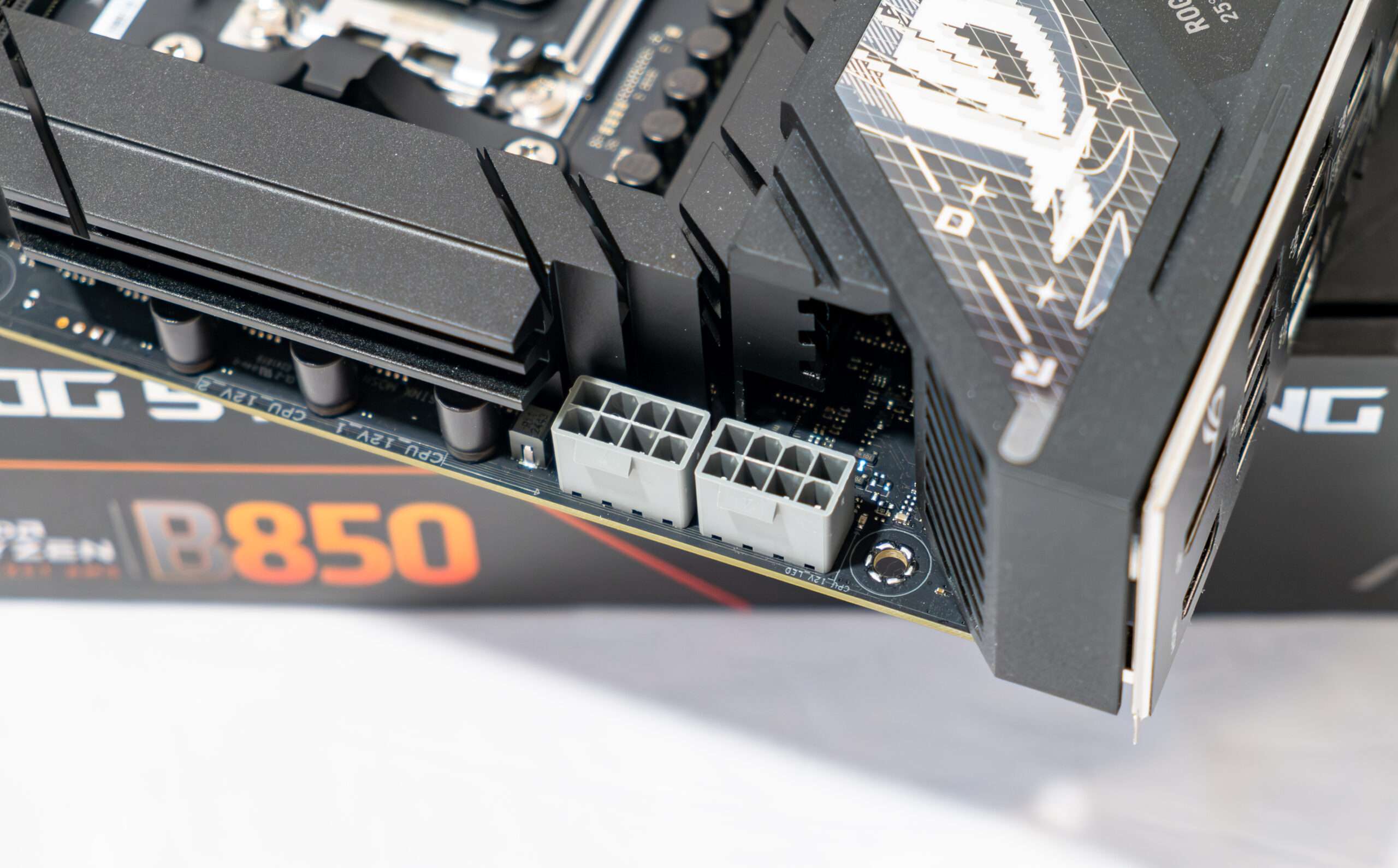
REALTEK ALC4080 CODEC
Typically, audio components are built into the motherboard’s PCB. The Realtek ALC4082 codec is paired with an Savitech SV3H712 amp for producing clean high-res audio with 120 dB SNR output and 110 dB SNR input and 32-bit / 384 kHz playback. I/O includes S/PDIF out that also supports 3.5mm mic input, and an additional support 3.5mm combo jack that can host mics or headphones.
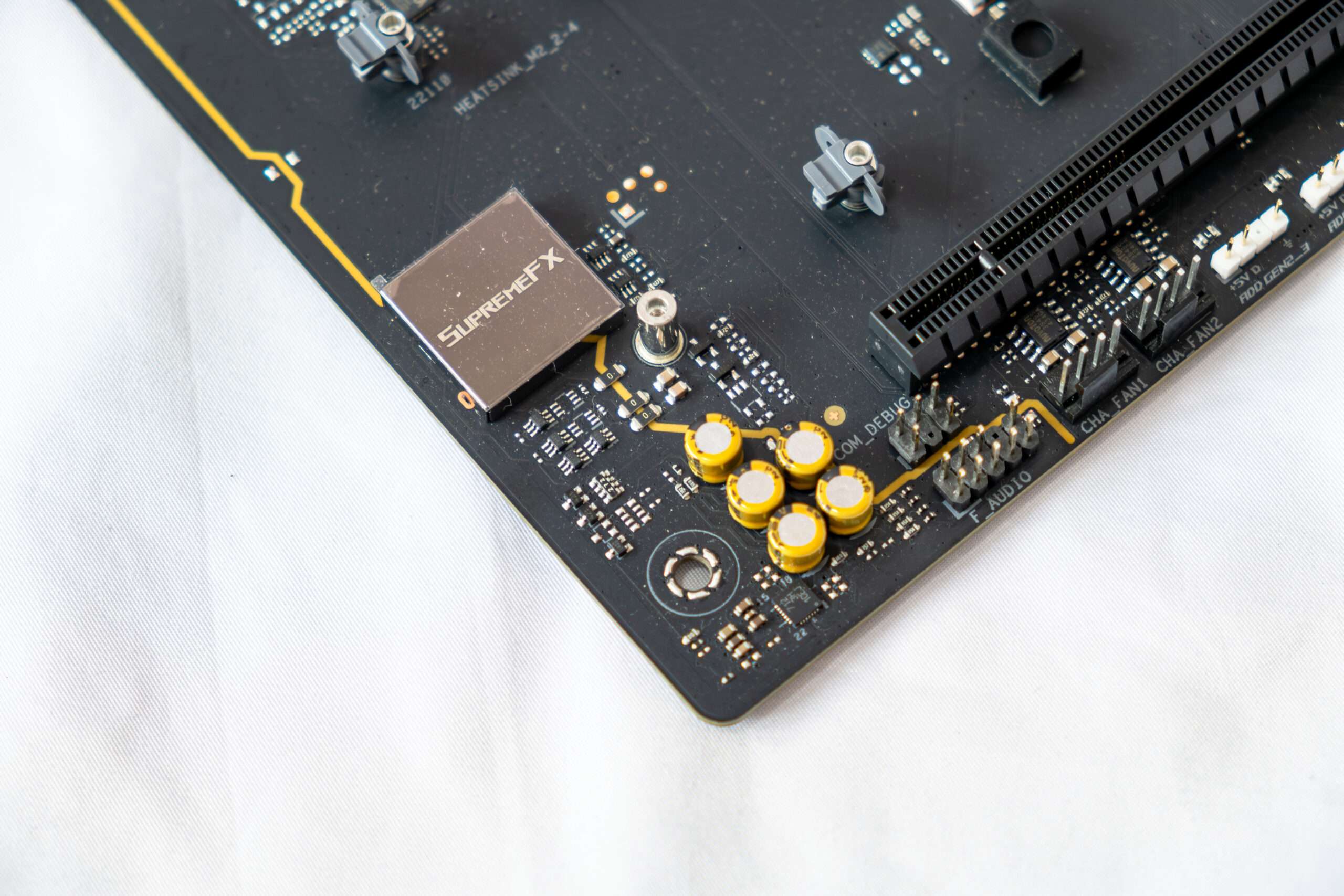
The ASUS ROG Strix B850-F Gaming WIFI motherboard is consider a higher tier board, but it does feature robust cooling for its MOSFETs. MOSFETs are an essential component of the motherboard’s power delivery system, responsible for regulating and supplying power to the CPU. ASUS has implemented heatsinks in the vicinity of the MOSFETs to aid in heat dissipation. These cooling features can contribute to better overall system stability and longevity, particularly when the motherboard is subjected to heavy loads or extended usage.
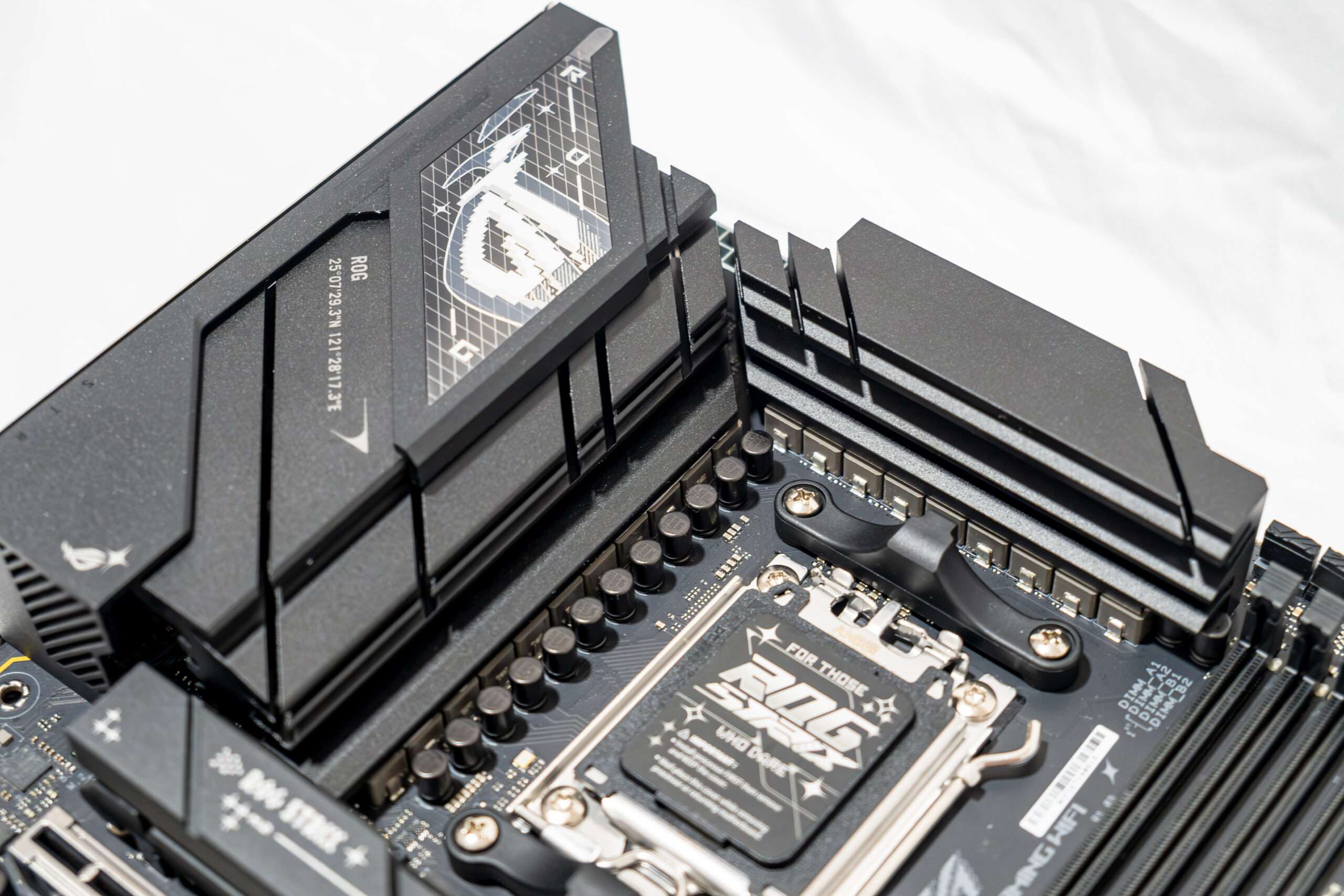
Power Phase Design & Component
The power supply unit is a 16+2 +2 phase configuration with teaming configuration and integrated MOSFETs. On this board, ASUS used Vishay integrated MOSFETs, which have a maximum continuous current of 80 A, which means that the CPU can receive a maximum of 1280 amps of current. The VRM controller is a ASP2308GQW proprietary design, and it is located on the top side of the board.
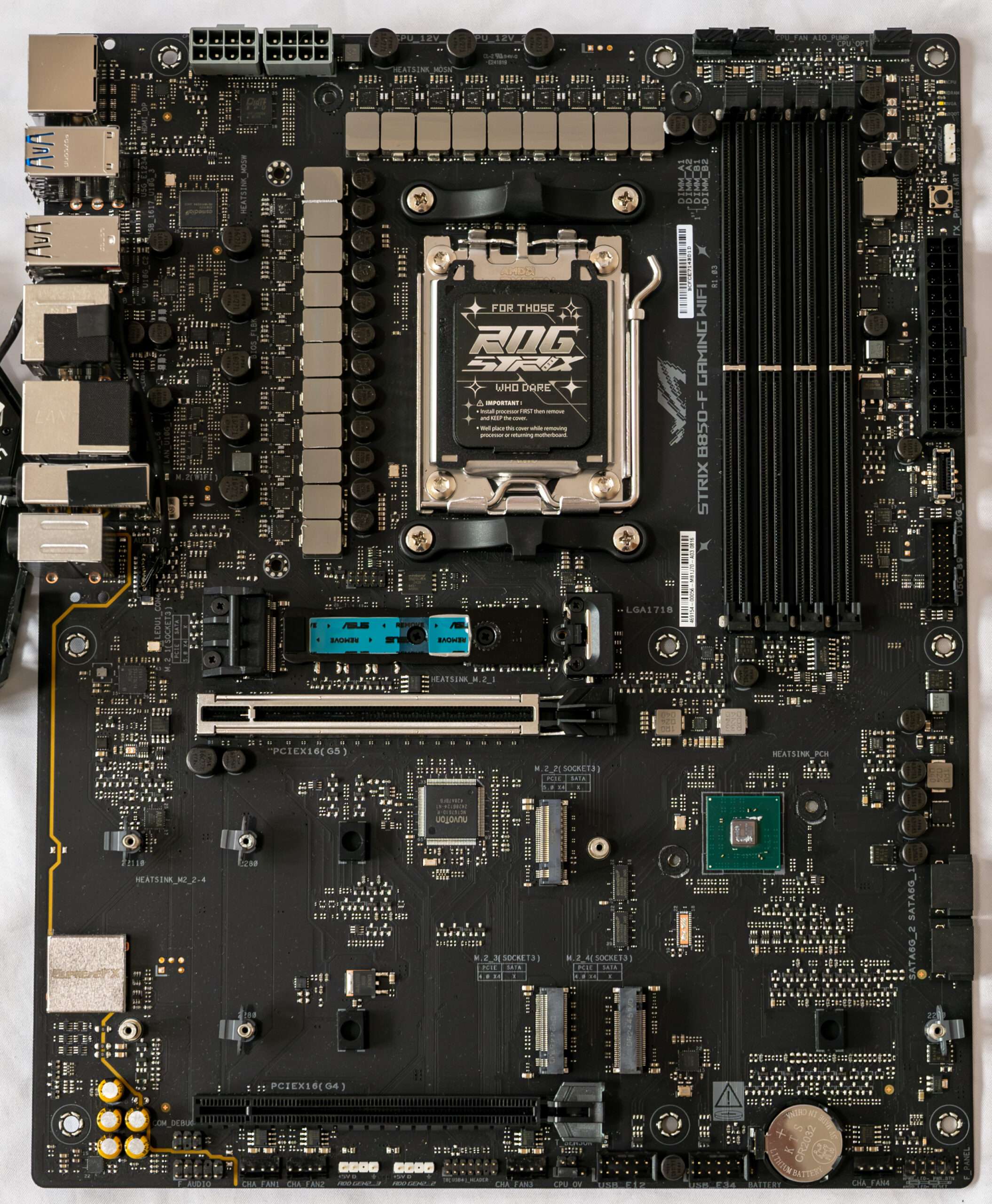
The processor power supply circuit is designed according to the 16+2+2 scheme (a total of 20 phases: 16 on VCore (processor core), 2 on iGPU (integrated graphics core), 2 on SoC (Ryzen I/O).
- Sixteen VCore phase channel has a superferrite choke and SIC629 (80 A) from Vishay
- Two VDD_MISC [IGPU] phase channel has a superferrite choke and SIC629 (80 A) from Vishay
- Two SoC [Ryzen I/O] phase channel has a superferrite choke and SIC629 (80 A) from Vishay
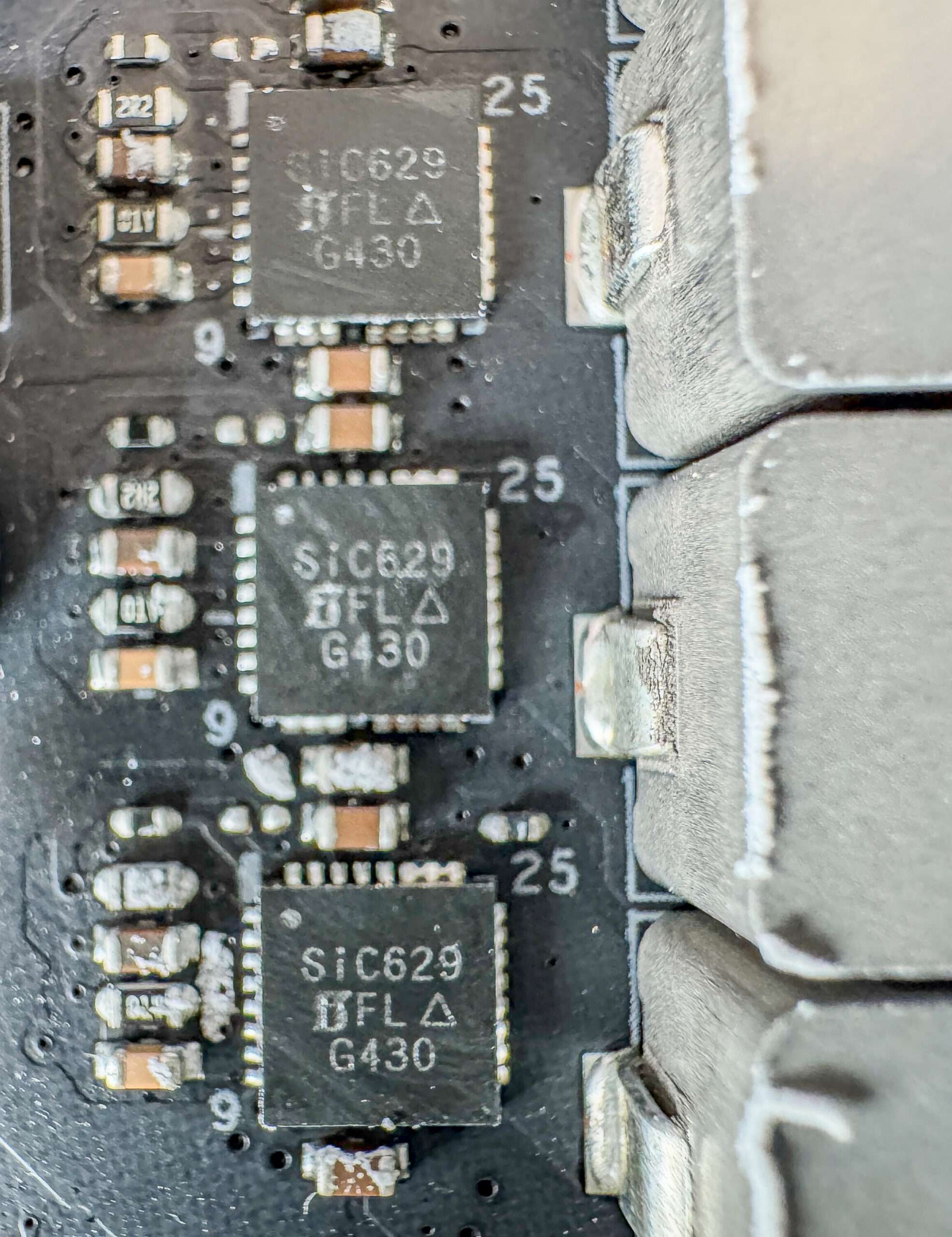
Richtek RT3672EE PWM contoller for VDD_MISC [IGPU] phase
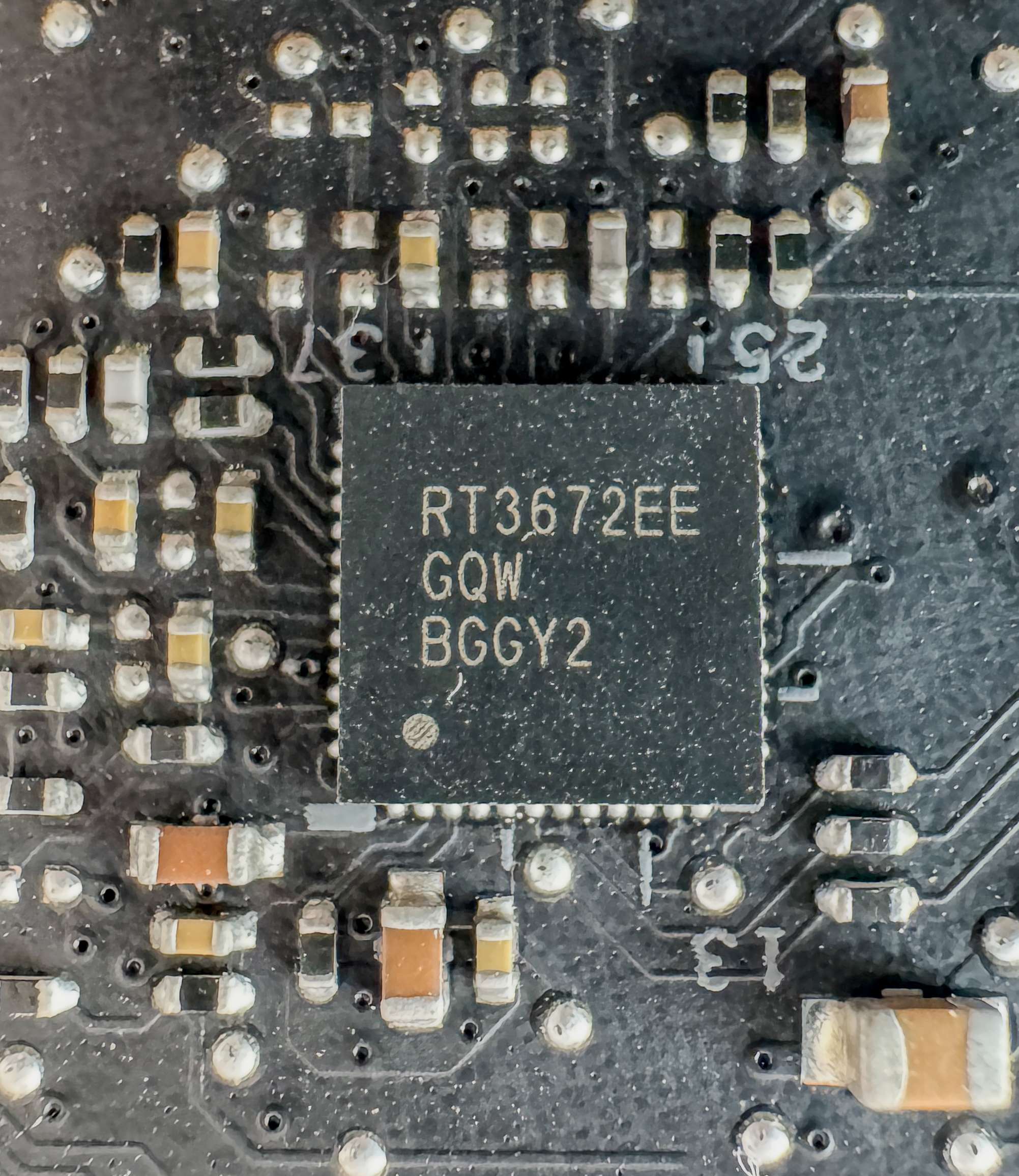
The control of the VCore and SoC phase is managed by the proprietary Digi+ ASP2308GQW PWM controller.
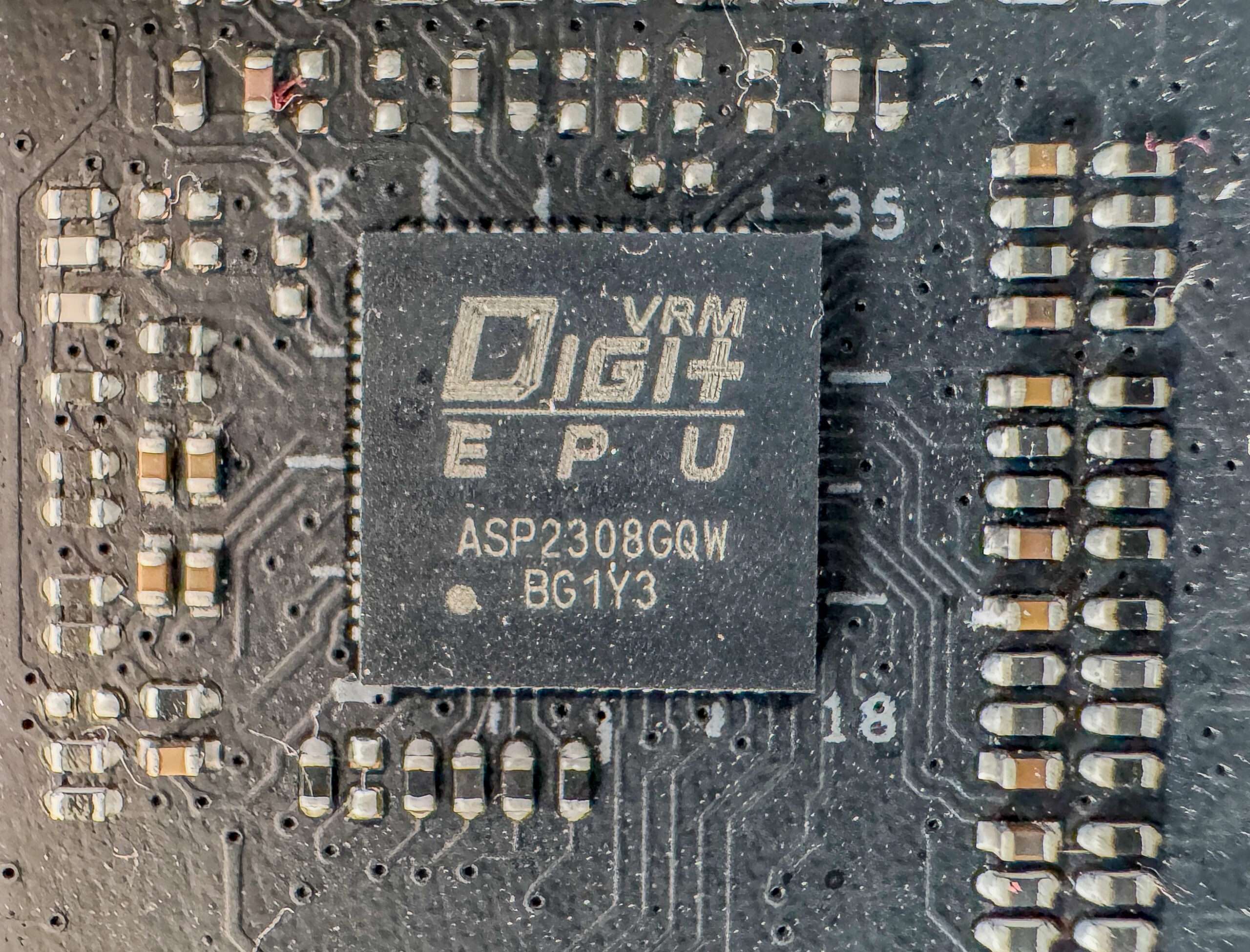
Intel Ethernet 2.5Gbe Controller I226-V S3273L04
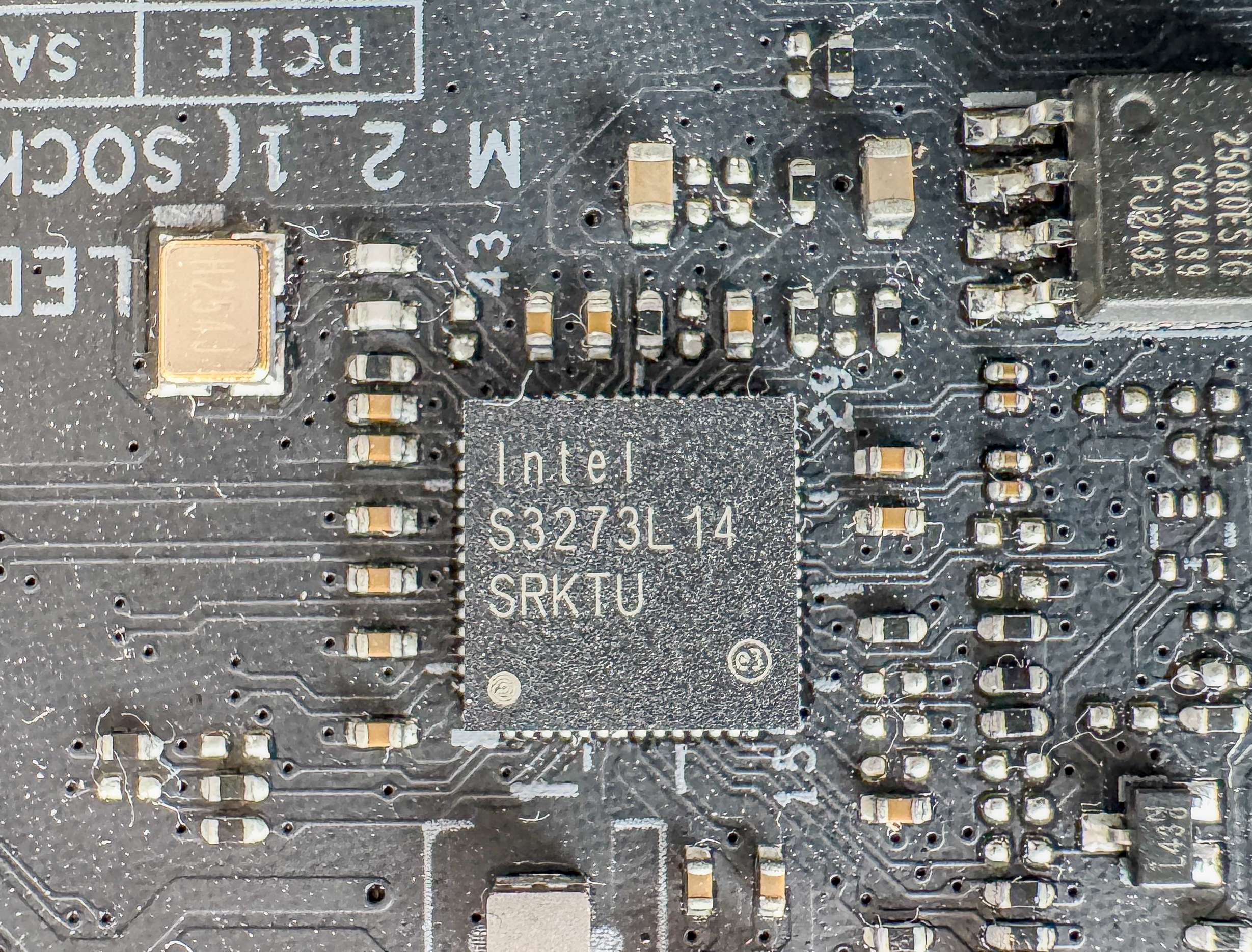
The ASMedia ASM1074 is a USB 3.2 Gen 1 4 Hub controller
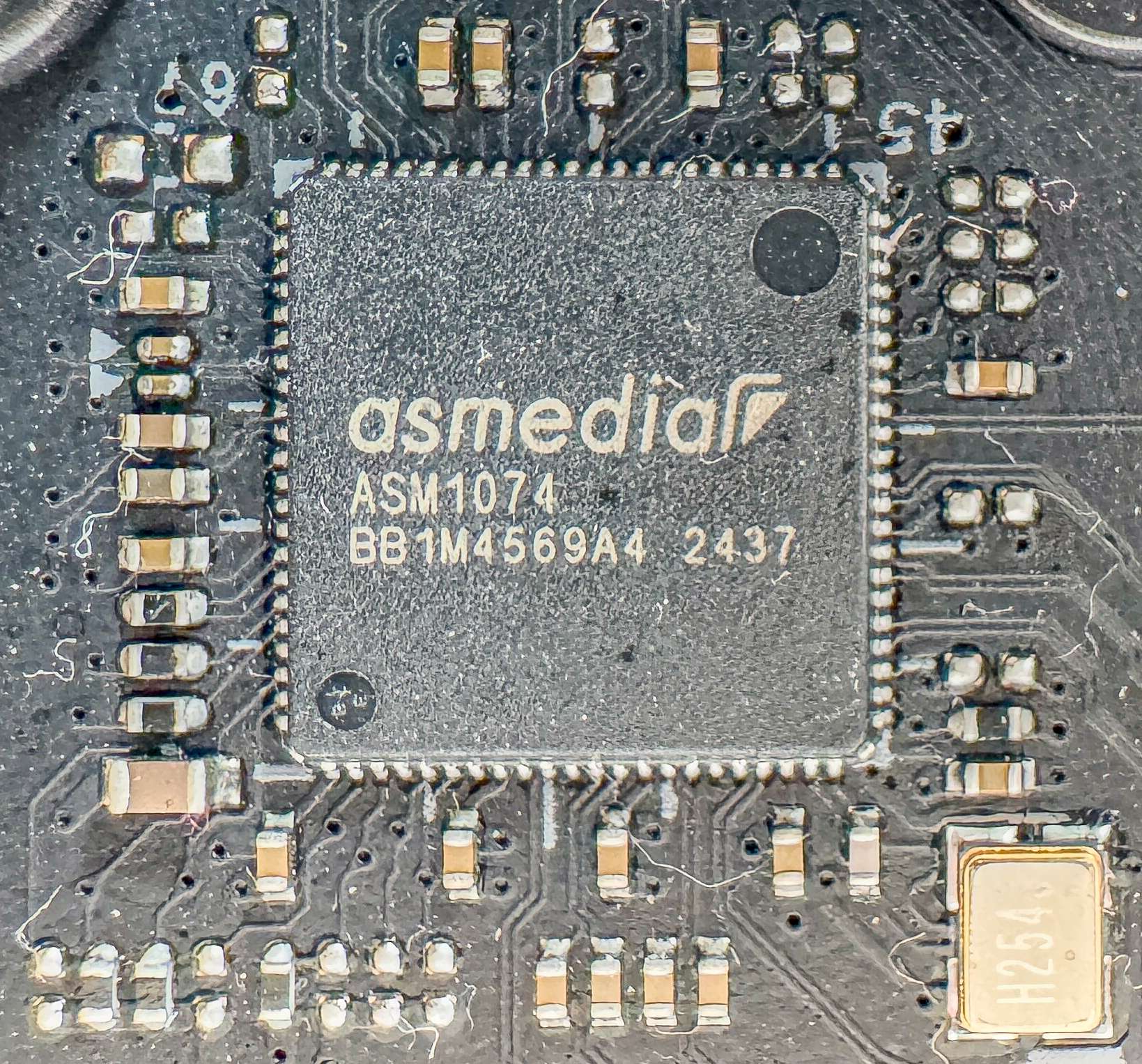
- AURA is a ARGB lighting controller
- MXIC is a SPI chip for BIOS
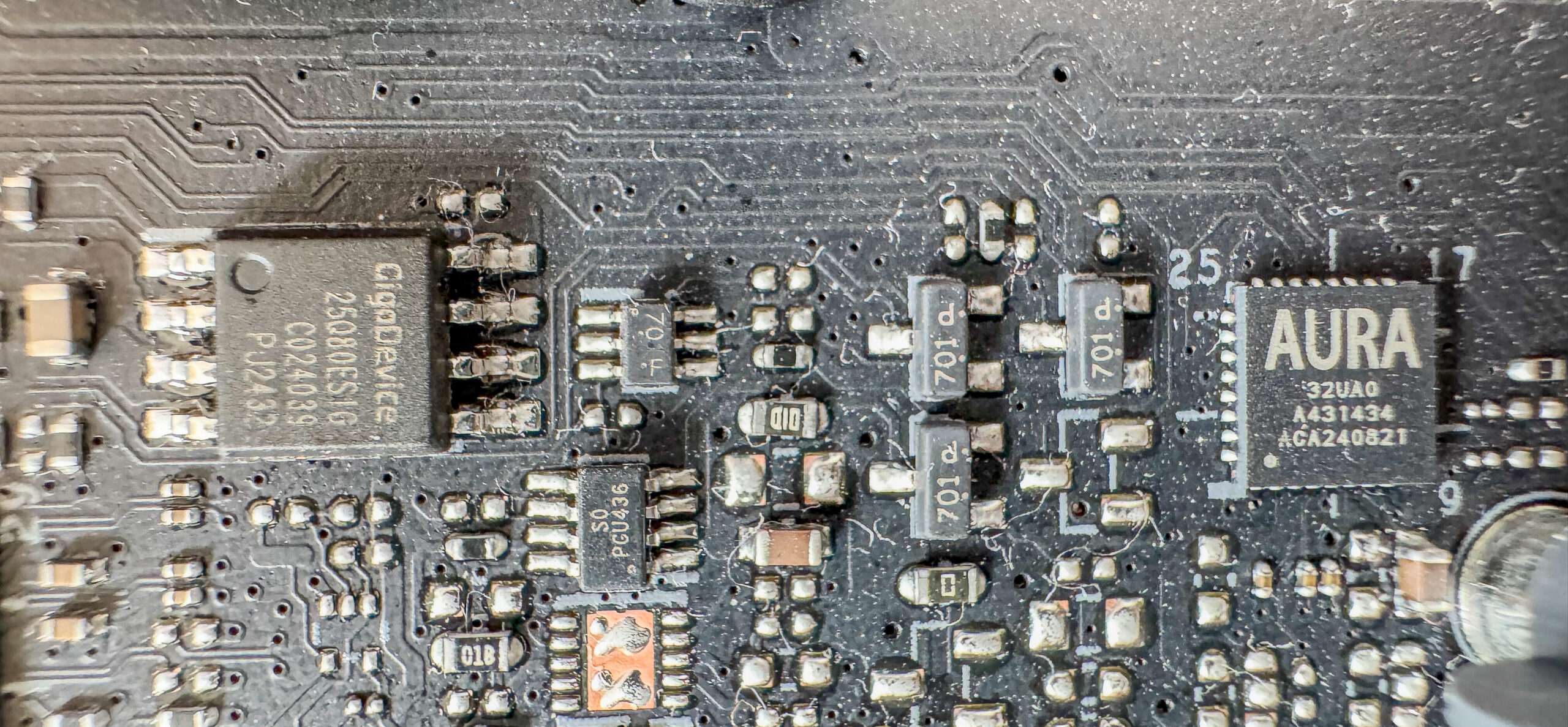
two ASmedia PCIe 4.0 Redriver IC ASM2480B provides high-speed transmission and multi-band independent bandwidth to M.2 and PCIE.
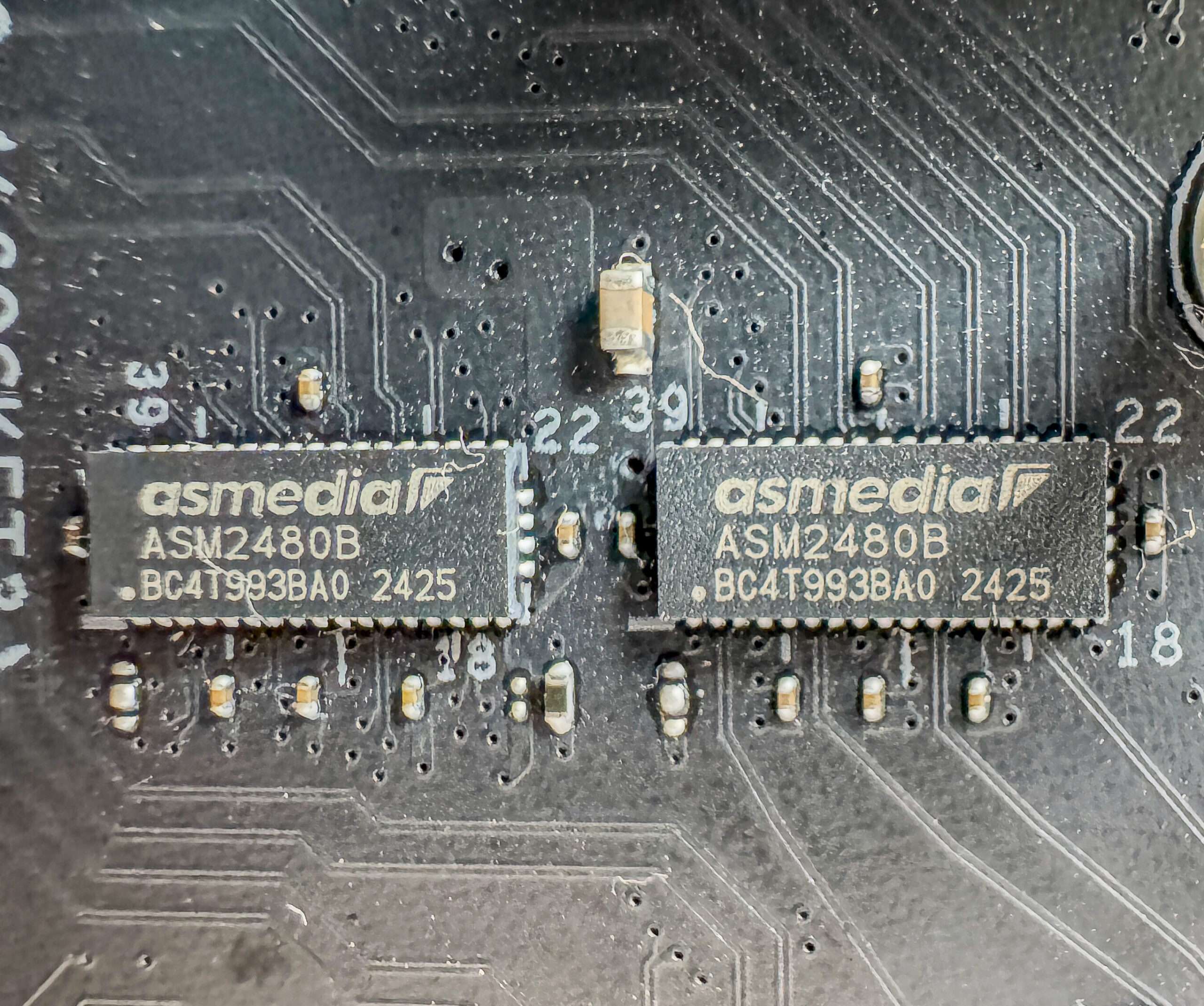
The Nuvoton NCT6701 controller is responsible for monitoring the motherboard’s status and coordinating the operation of all CO (Centralized Onboard) sockets.
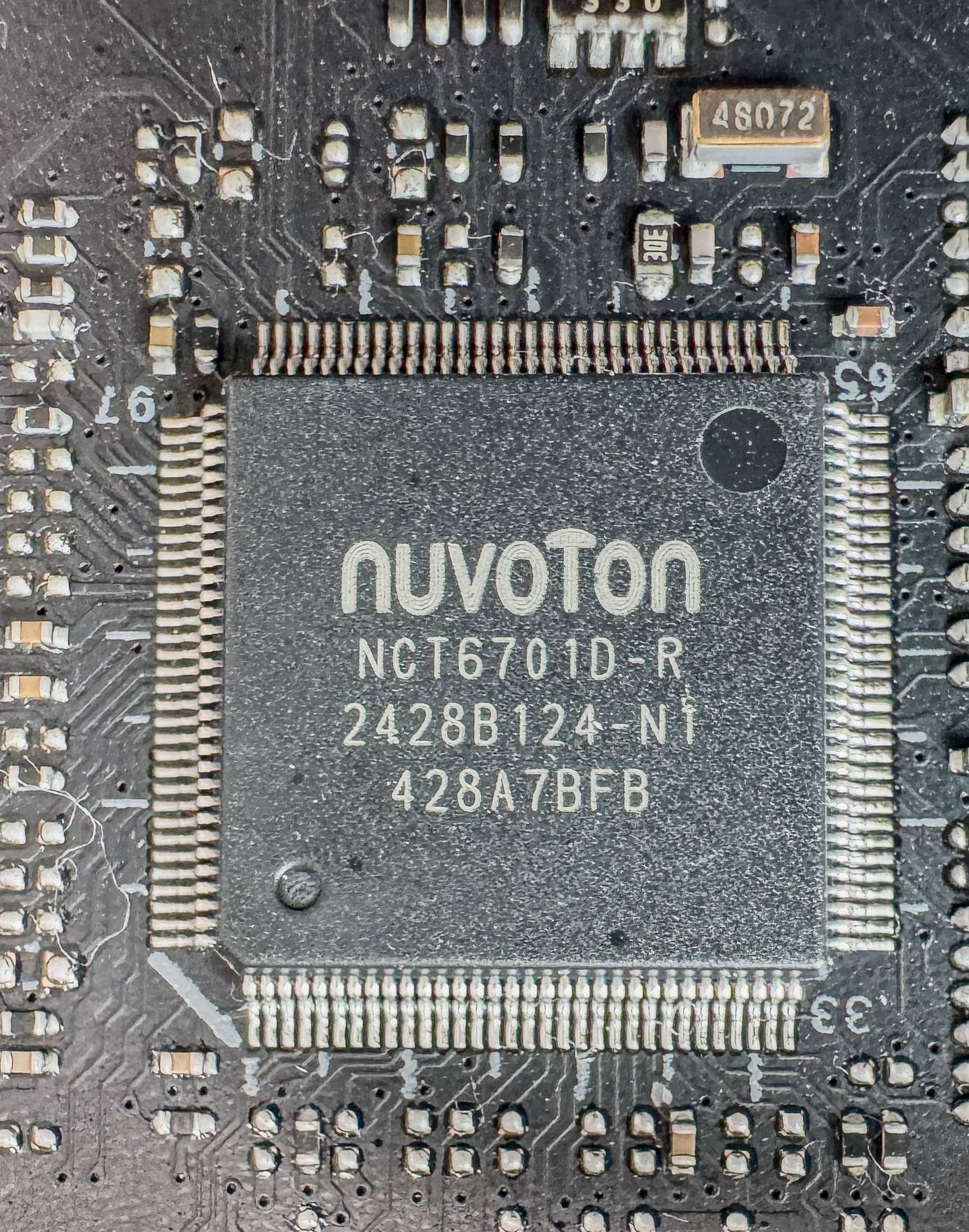
Genesys Logic GL850G USB 2.0 port controllers use USB 2.0 lines from B850 Chipset.
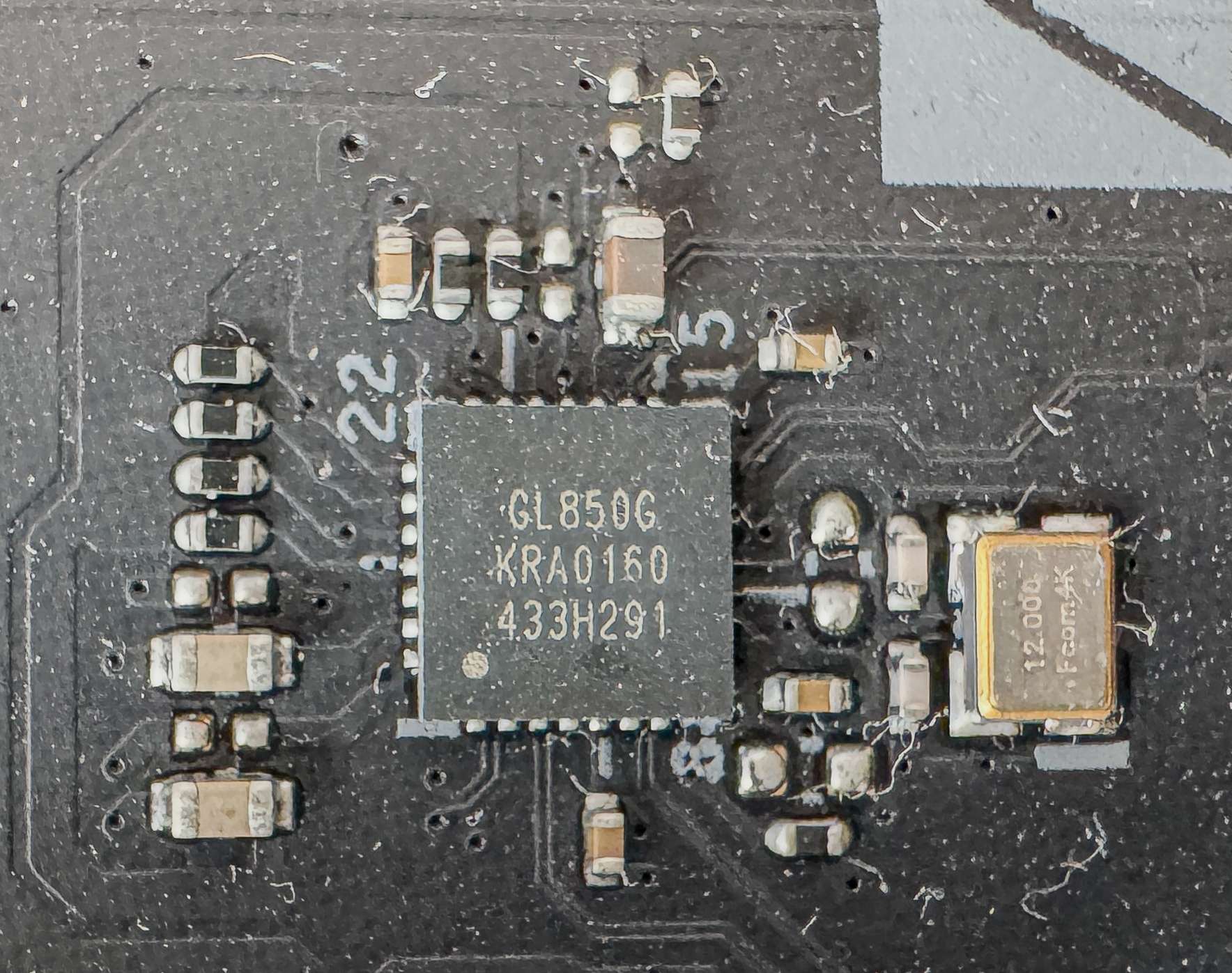
The ASMedia ASM1543 controller is a switch chip for USB 3.2 Gen 2 Type C internal header.
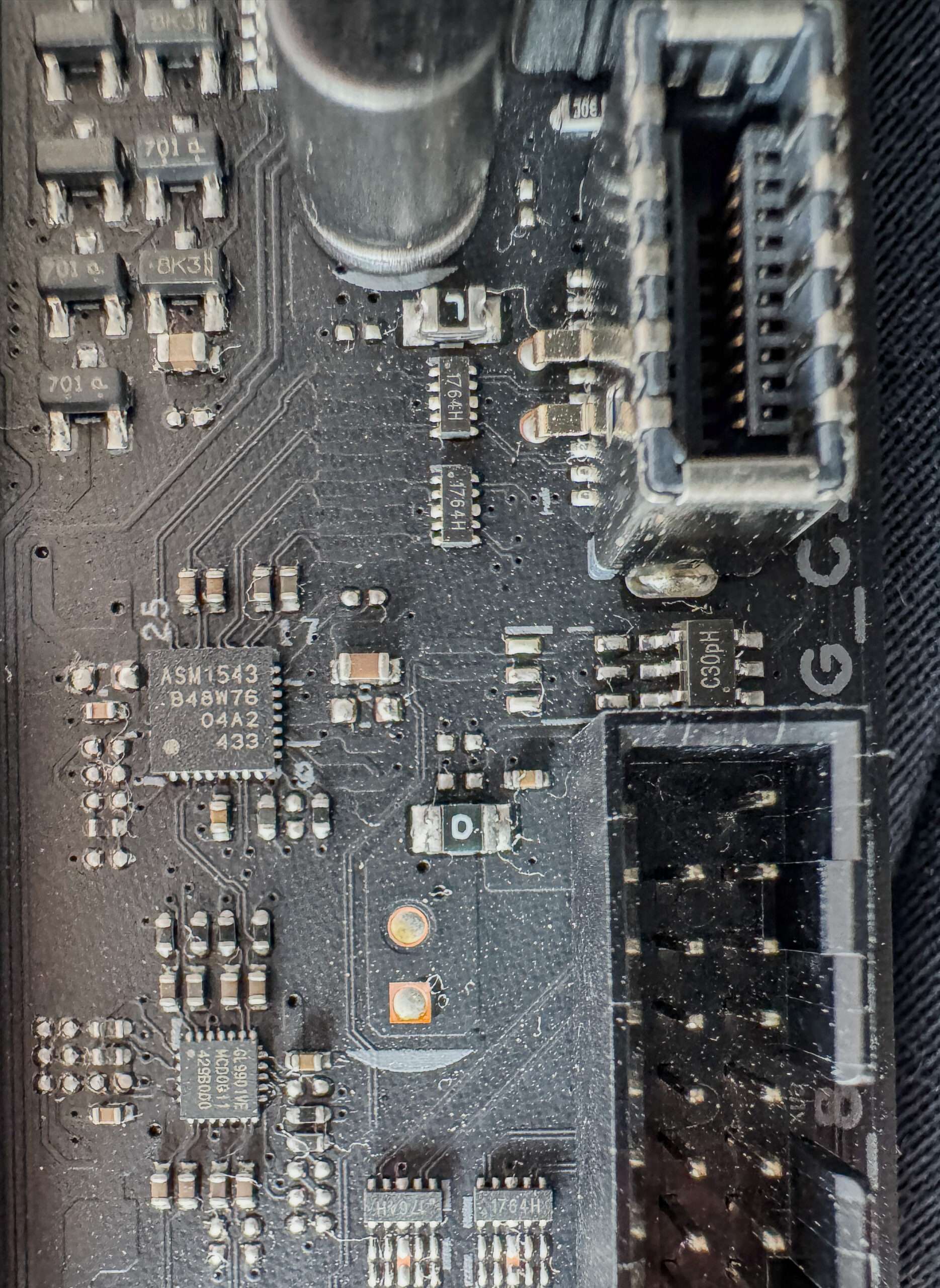
AMD B850 Chipset
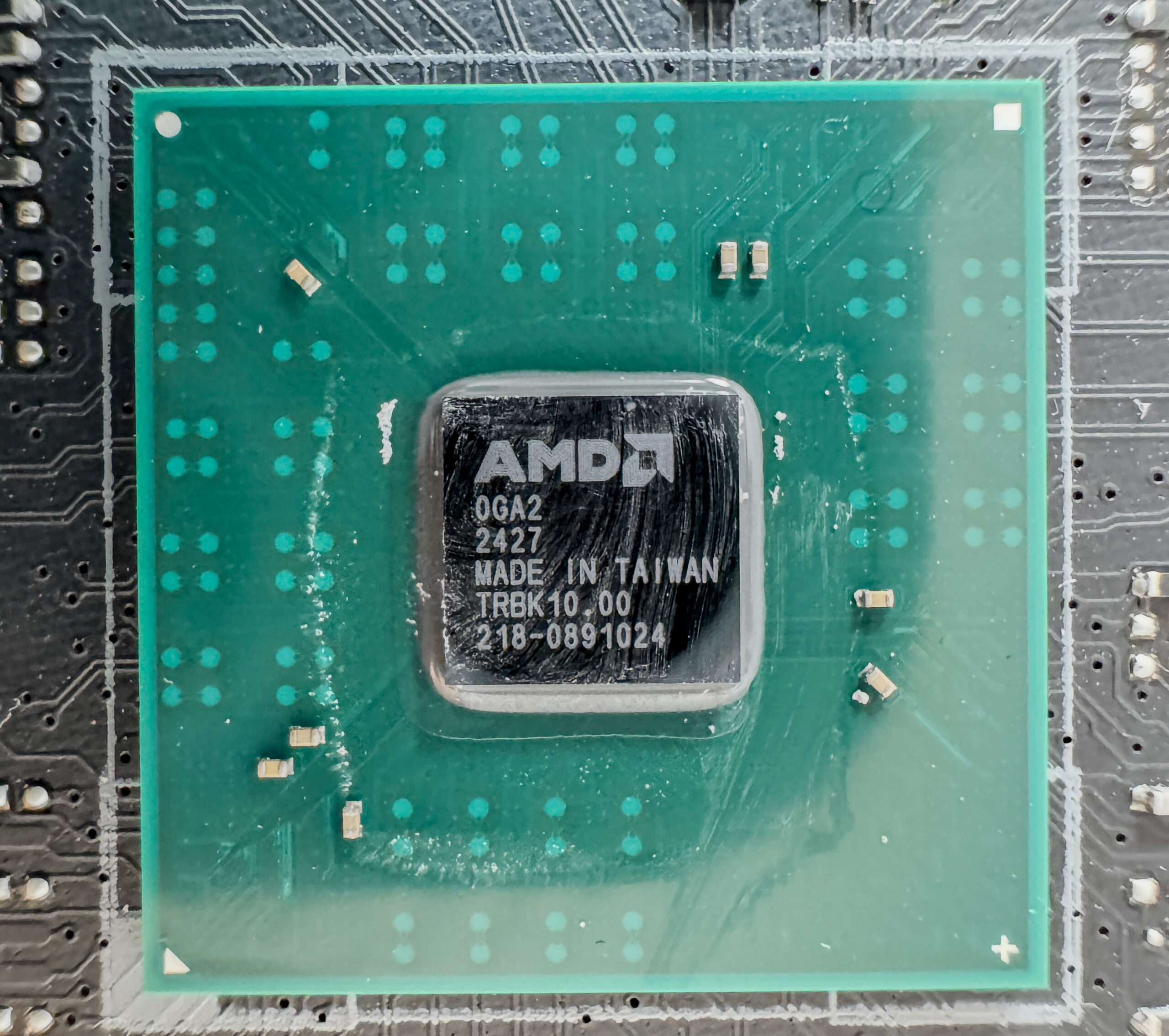
How We Test ASUS ROG STRIX B850-F Gaming WIFI?
AMD B850M-PLUS WIFI is a mid range motherboard from ASUS. As such, our workstation, based on an TUF B850M-PLUS WIFI motherboard and Ryzen 9 9950X 16 cores 32 threads processor. The ram we will be using KLEVV DDR5 7200Mhz memory kit. ASUS ROG STRIX RTX4080 and ADATA PCIe 4.0 1TB SSD is used as well to run with benchmark. On the Comparison, we will be using 3 systems to run side by side to see perform better.
| System 1 | System 2 | System 3 | |
| Motherboard | ASRock B850M-X WIFI | ASRock B860M-X WIFI | ASUS ROG Strix B850-F Gaming WIFI |
| Processor | AMD Ryzen 9 9950X | Intel Ultra 9 285K | AMD Ryzen 9 9950X |
| Ram | KLEVV DDR5 32GB 7200Mhz CL34 | KLEVV DDR5 32GB 7200Mhz CL34 | KLEVV DDR5 32GB 7200Mhz CL34 |
| SSD | Lexar NM790 1TB NVMe PCIe Gen4 | Lexar NM790 1TB NVMe PCIe Gen4 | Lexar NM790 1TB NVMe PCIe Gen4 |
| Graphics | ROG STRIX RTX4080 OC | ROG STRIX RTX4080 OC | ROG STRIX RTX4080 OC |
| Cooler | EK-D AIO 360 III 360mm With Liquid Metal | EK-D AIO 360 III 360mm With Liquid Metal | EK-D AIO 360 III 360mm With Liquid Metal |
| BIOS | 3.2 | 1.12 | 1006 |
| OS | Windows 11 64bits 24H23 Build 26100.3194 | Windows 11 64bits 24H23 Build 26100.3194 | Windows 11 64bits 24H23 Build 26100.3194 |
System Information
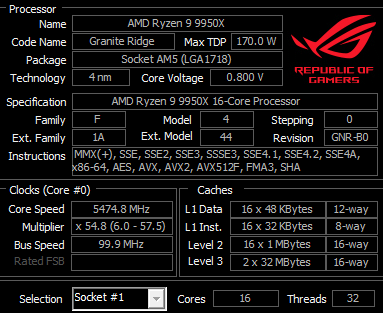
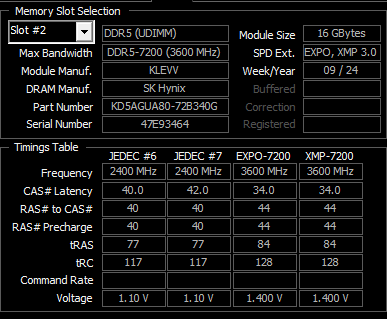
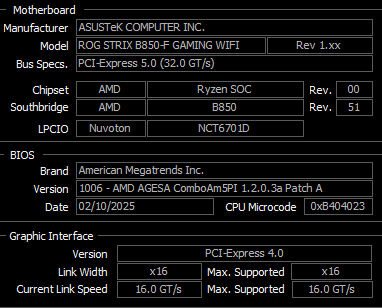
PCMark 10
PCMark 10 features a comprehensive set of tests that cover the wide variety of tasks performed in the modern workplace. With a range of performance tests, custom run options, Battery Life Profile, and new Storage benchmarks, PCMark 10 is the complete PC benchmark for the modern office.
| Essentials | Productivity | Digital Content Creation | Score | |
| ASRock B850M-X WIFI | 11989 | 12581 | 19660 | 10300 |
| ASRock B860M-X WIFI | 11190 | 11029 | 19314 | 9577 |
| ROG STRIX B850-F Gaming WIFI | 12140 | 13248 | 20121 | 10605 |
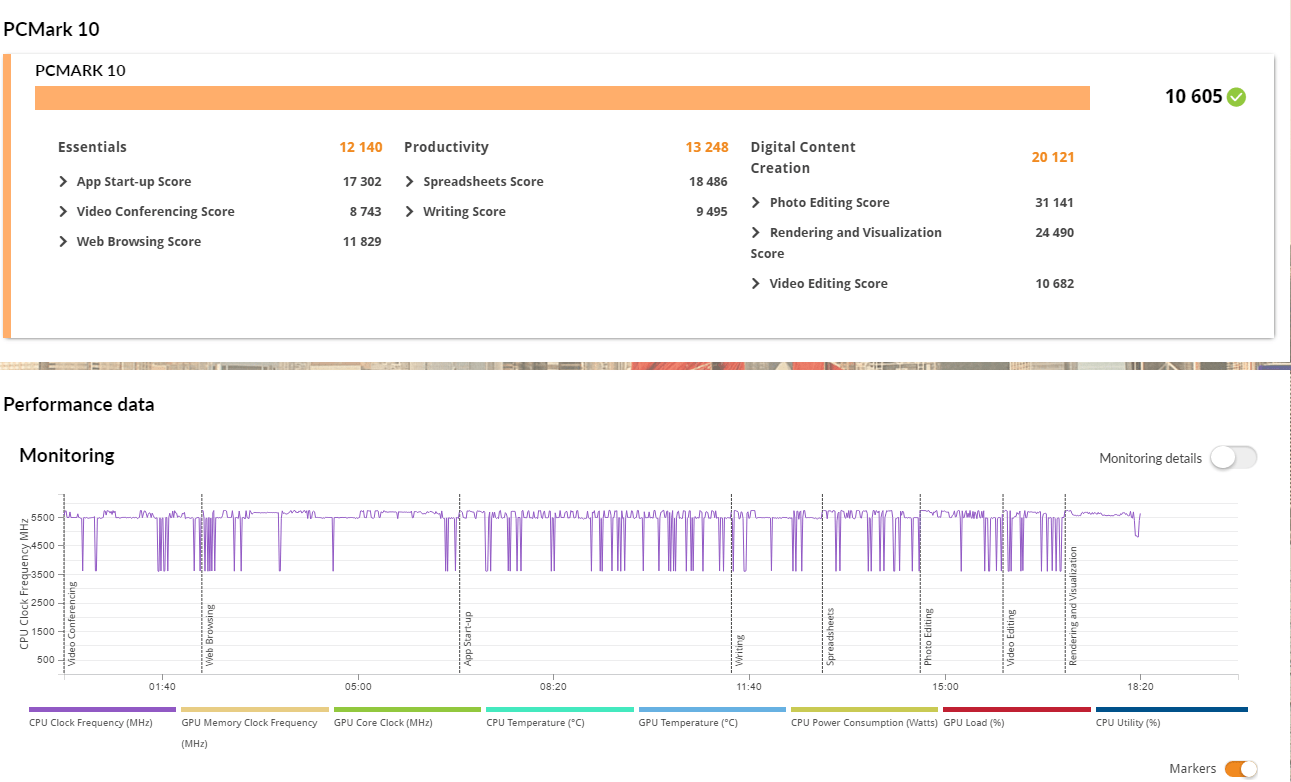
3Dmark Advanced Edition
3DMark includes everything you need to benchmark your PC and mobile devices in one app. Whether you’re gaming on a smartphone, tablet, notebook, or a desktop gaming PC, 3DMark includes a benchmark designed specifically for your hardware.
| Max Threads | 16 Threads | 8 Threads | 4 Threads | 2 Threads | 1 Threads | |
| ASRock B850M-X WIFI | 15998 | 15631 | 9353 | 5008 | 2568 | 1298 |
| ASRock B860M-X WIFI | 18903 | 14990 | 9772 | 5234 | 2735 | 1401 |
| ROG STRIX B850-F Gaming WIFI | 16481 | 16552 | 9193 | 4915 | 2555 | 1280 |
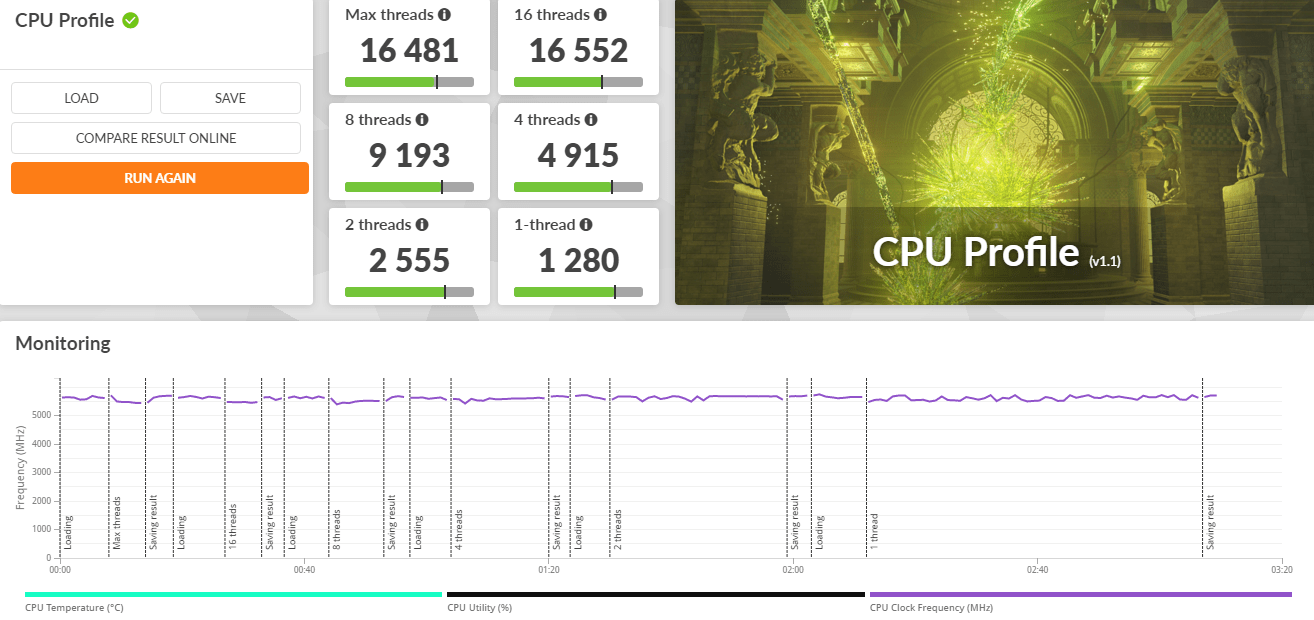
| ROG STRIX B850-F Gaming WIFI | ASRock B850M-X WIFI | ASRock B860M-X WIFI | |
| Fire Strike Ultra | 18028 | 18046 | 17939 |
| Time Spy Extreme | 13995 | 13697 | 14146 |
| Solar Bay | 142869 | 14295 | 13980 |
| Port Royal | 18486 | 18514 | 18380 |
| Steel Nomad | 6727 | 6732 | 6743 |
| Speed Way | 7485 | 7458 | 7480 |
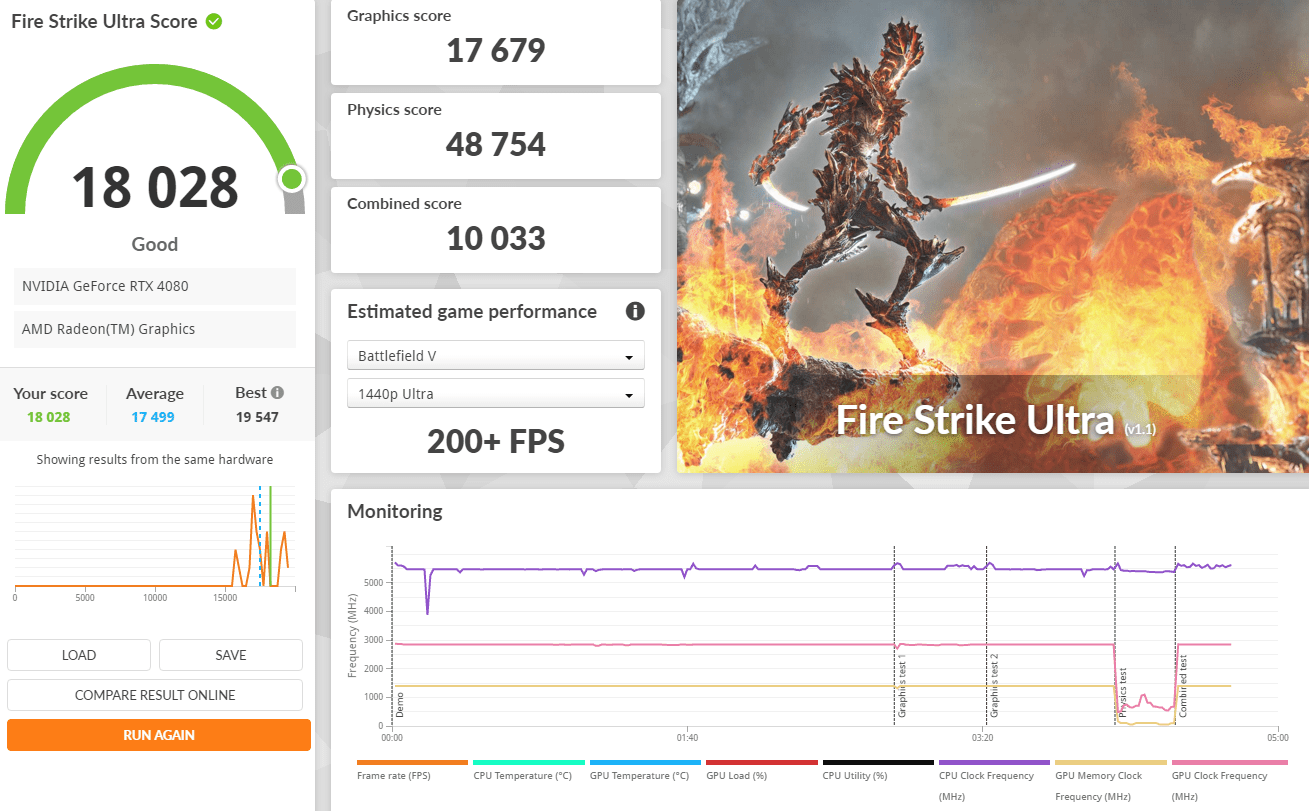
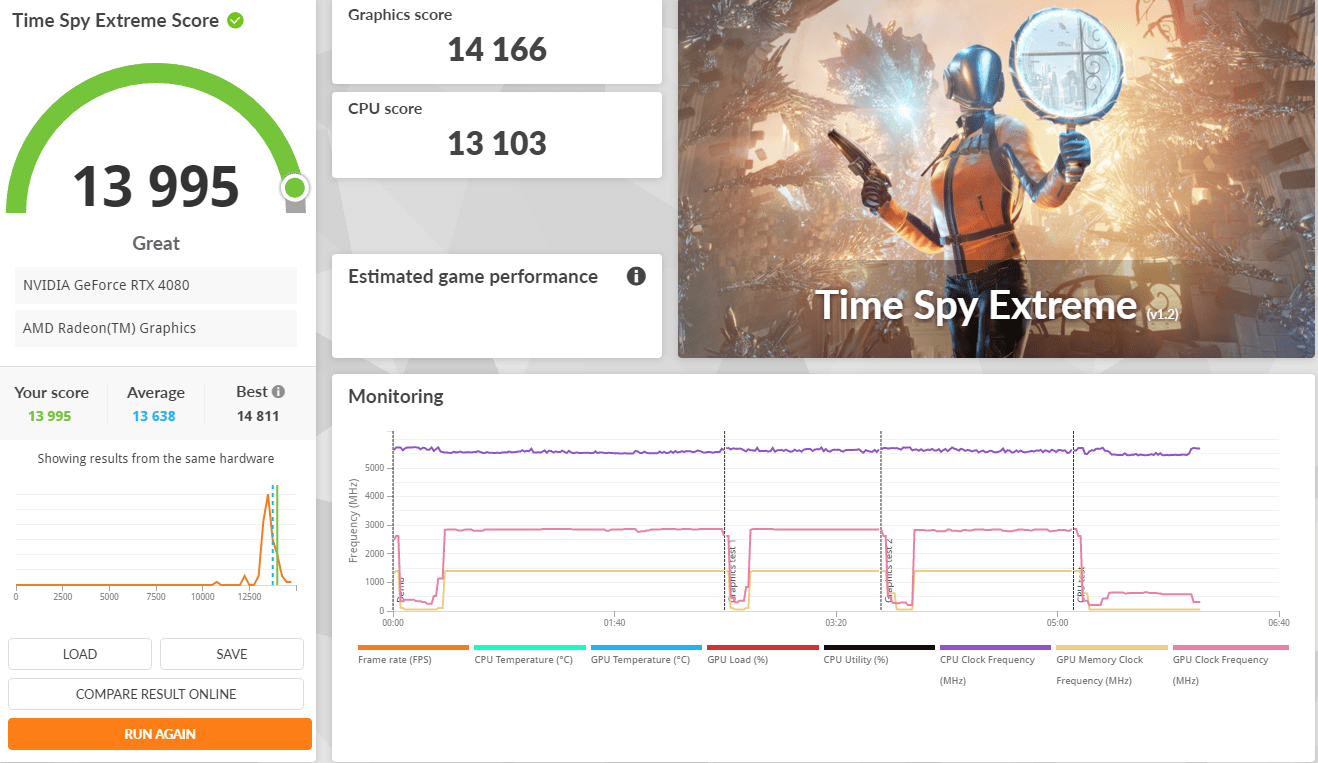
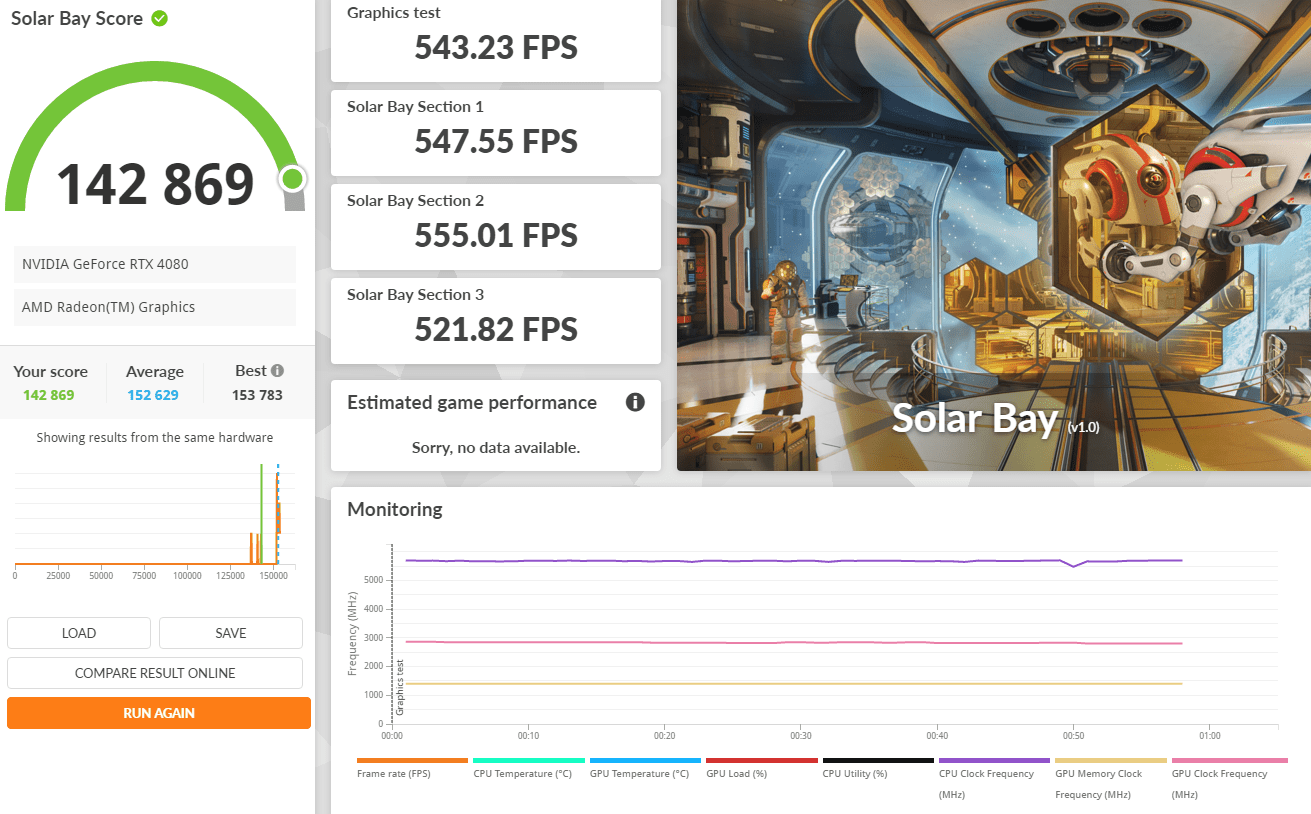
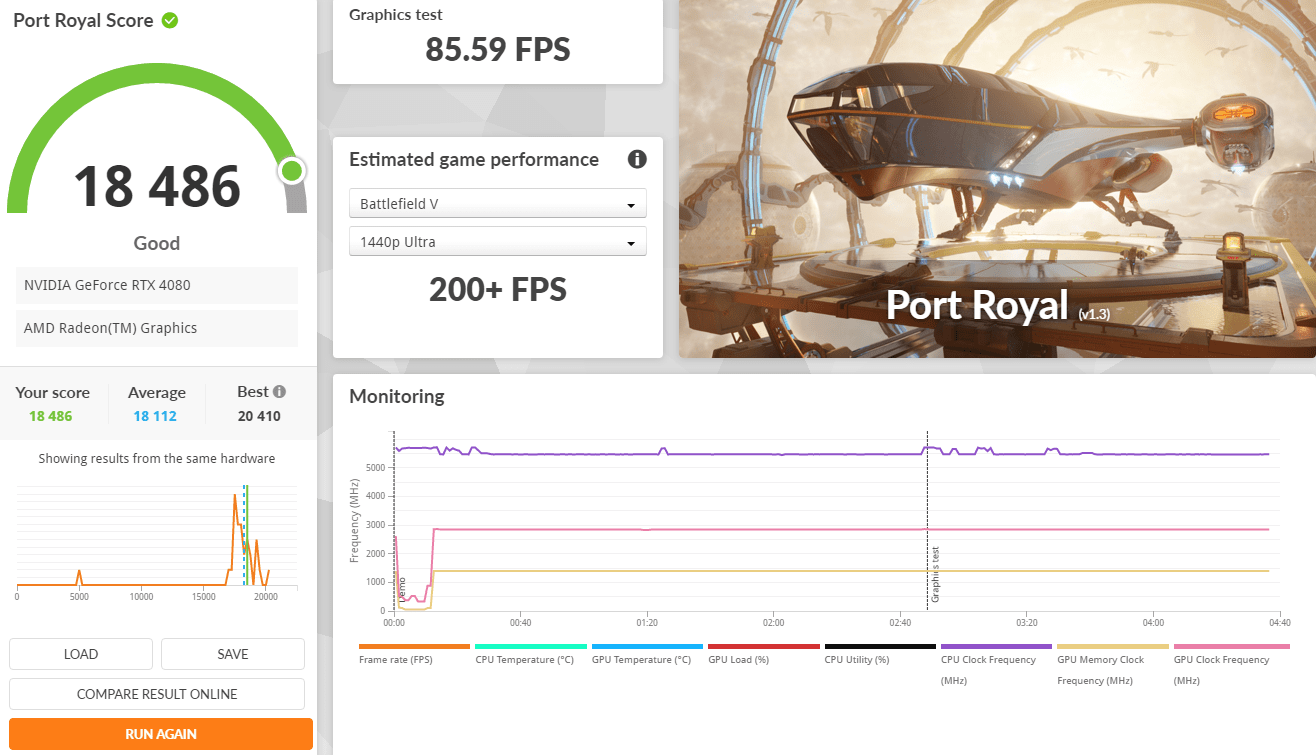
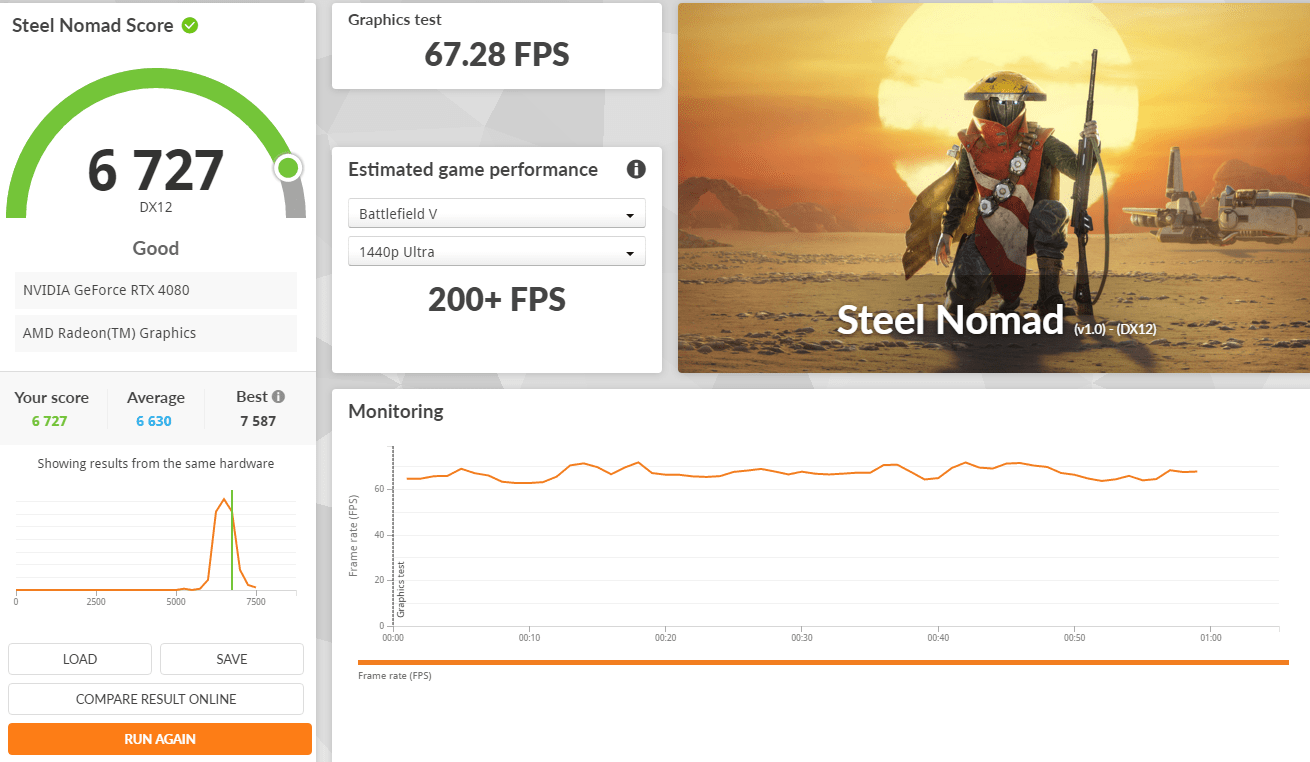
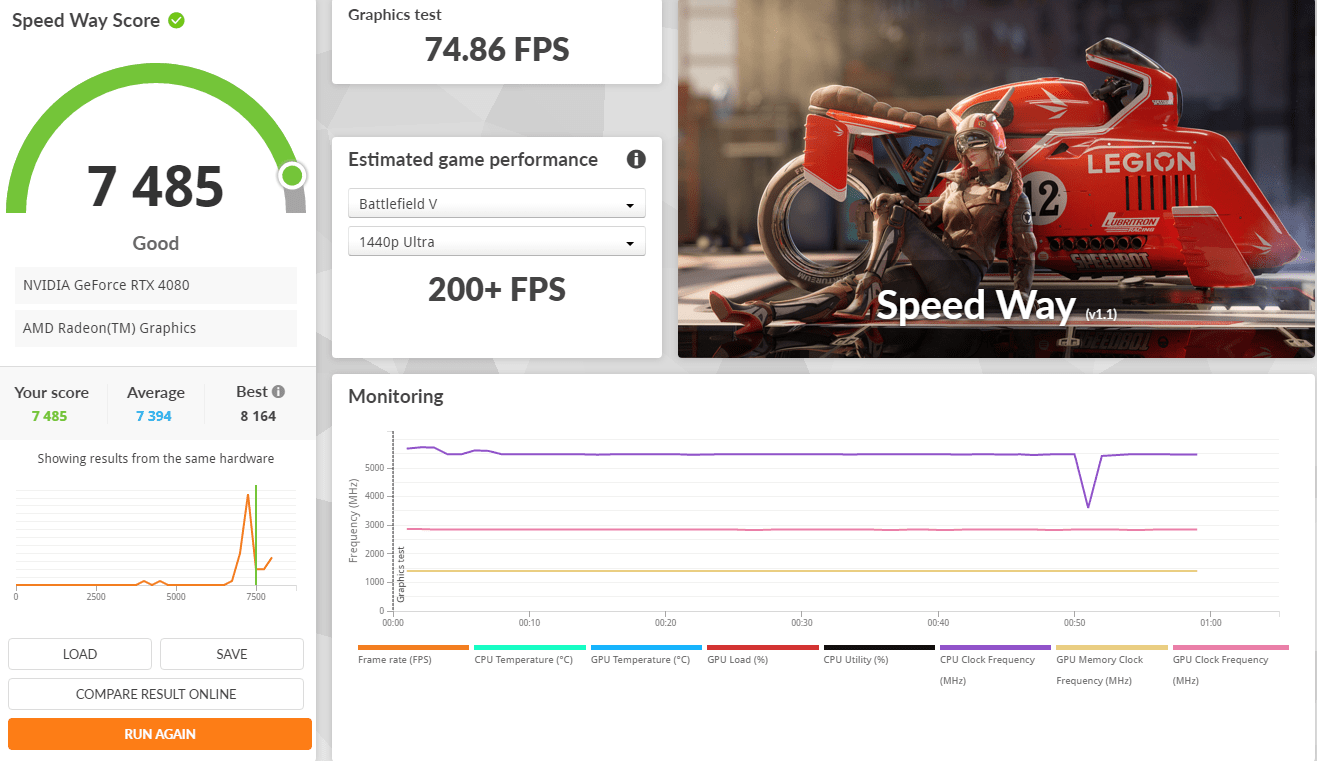
“Black Myth: Wukong”. It evaluates your hardware performance and system compatibility through the real-time rendering of an in-game sequence
| ROG STRIX B850-F Gaming WIFI | ASRock B850M-X WIFI | ASRock B860M-X WIFI | |
| Average FPS | 38 | 38 | 81 |
| Maximum FPS | 45 | 45 | 95 |
| Minimum FPS | 30 | 26 | 66 |
| Low 5th FPS | 32 | 32 | 70 |
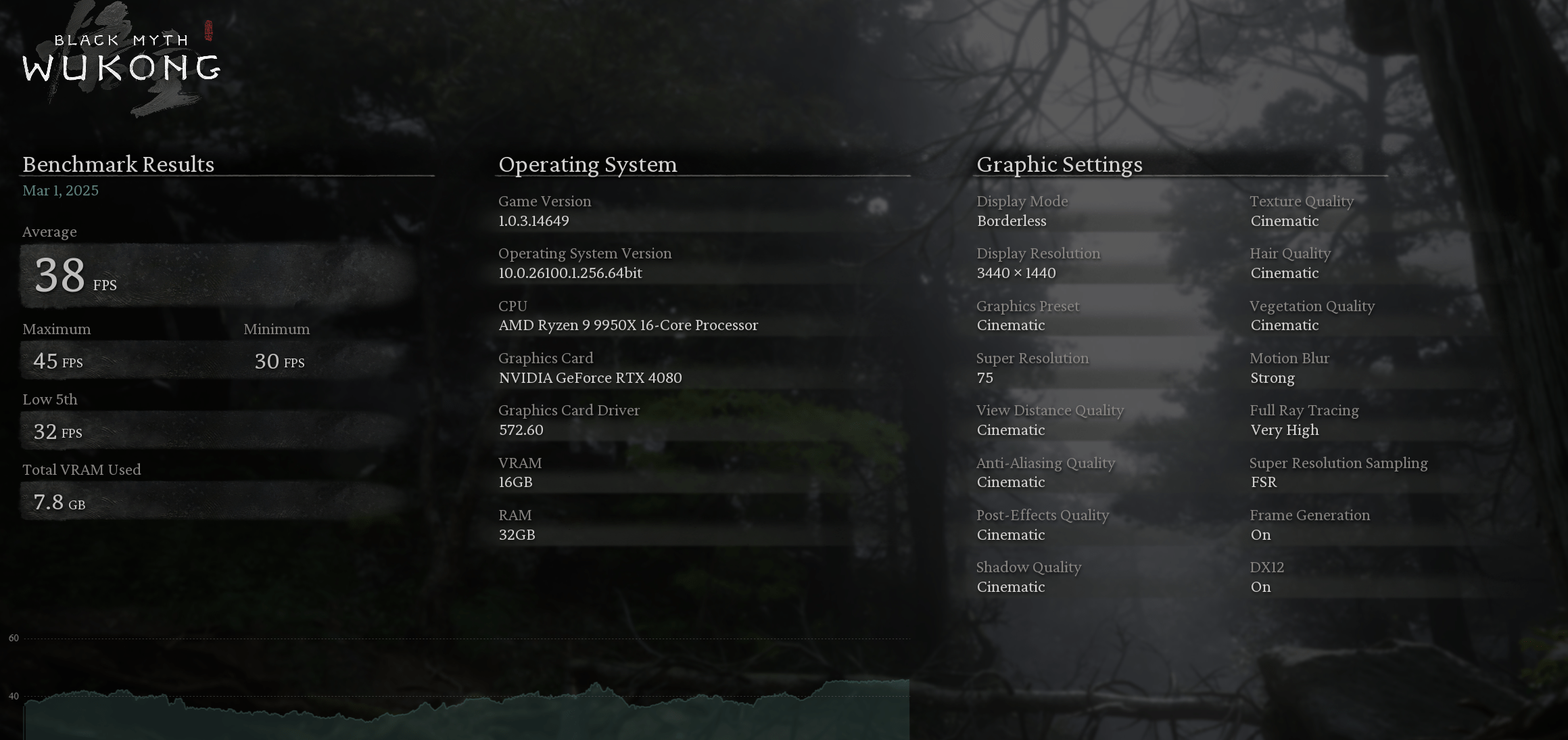
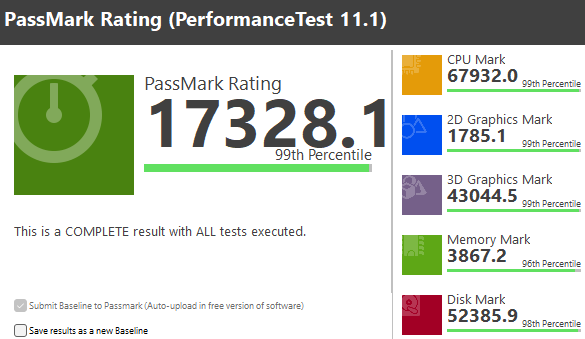
Should you buy ASUS ROG STRIX B850-F Gaming WIFI Motherboard?
Purchase: Click Here
The ASUS ROG STRIX B850-F Gaming WiFi is a feature-packed motherboard that delivers exceptional performance, robust connectivity, and stylish aesthetics, making it a great choice for gamers and power users alike. With support for AMD Ryzen 9000, 8000 and 7000 series processors, WiFi 7, 2.5Gb Ethernet, PCIe 5.0, and high-quality SupremeFX audio, this motherboard offers a well-rounded package for those looking to build a high-performance gaming rig. Its solid power delivery and cooling solutions ensure stability even under heavy workloads, while the user-friendly BIOS and AI Overclocking make it easy to fine-tune your system for optimal performance. The addition of customizable RGB lighting and premium build quality further enhance its appeal, making it a stylish yet powerful centerpiece for any gaming setup.
Overall, the ROG STRIX B850-F Gaming WiFi stands out as a good choice for AMD enthusiasts, offering future-proof features, excellent connectivity, and ASUS’s signature reliability. Whether you’re a hardcore gamer or a PC enthusiast, this motherboard provides the foundation for a powerful and immersive gaming experience.
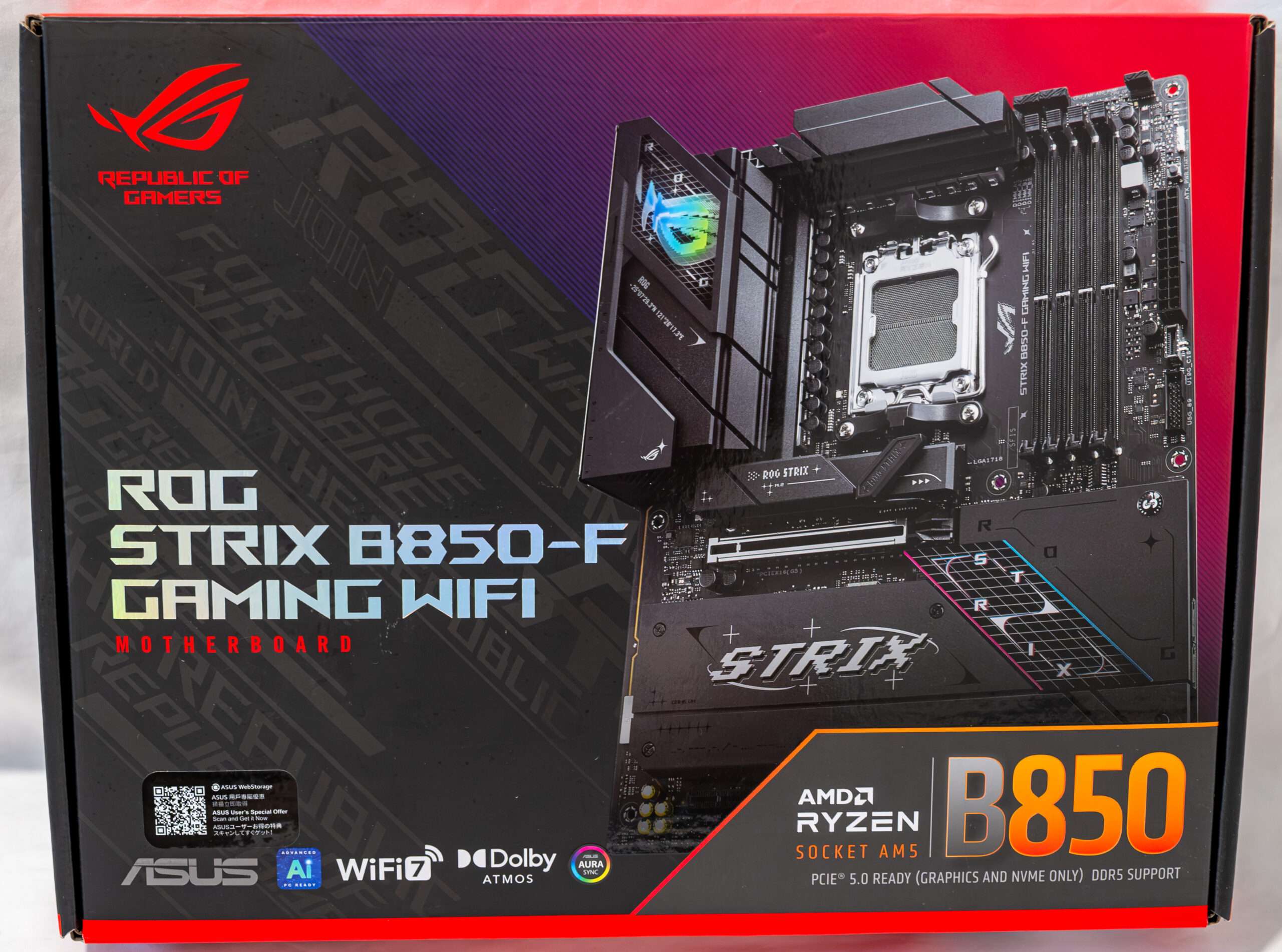
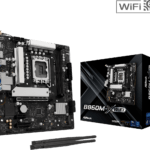
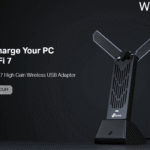


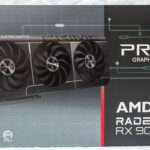
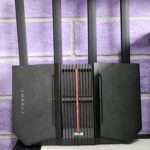

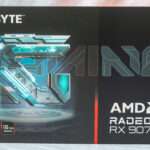
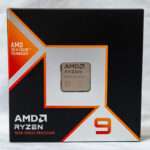
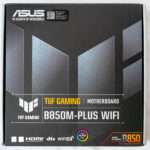

I truly appreciate your technique of writing a blog. I added it to my bookmark site list and will